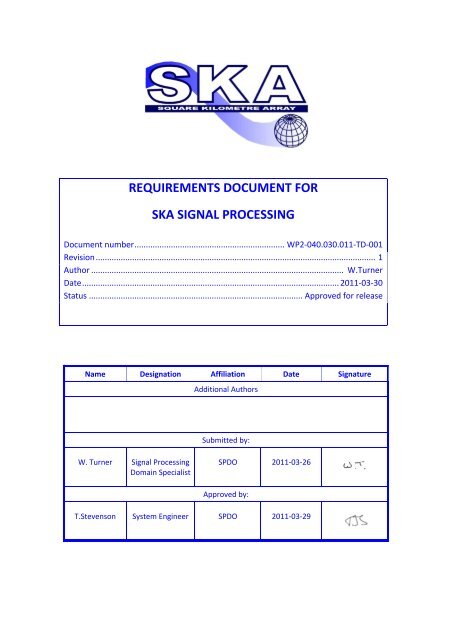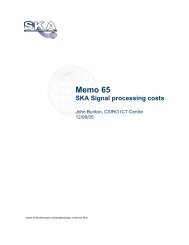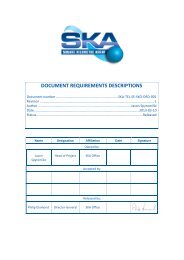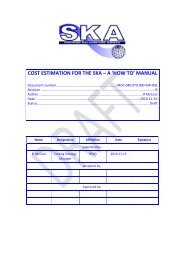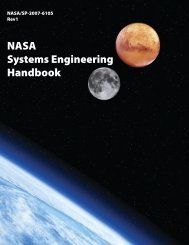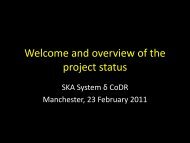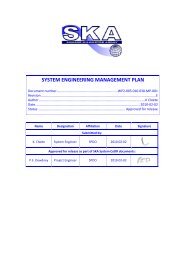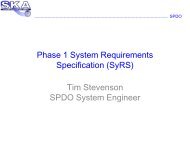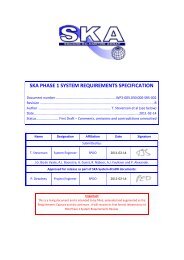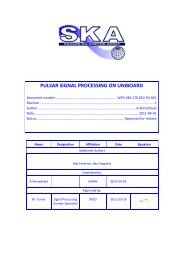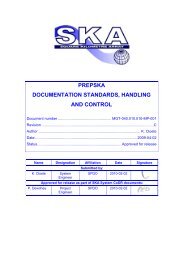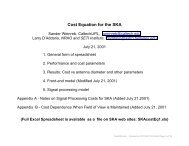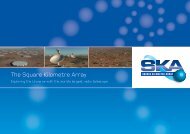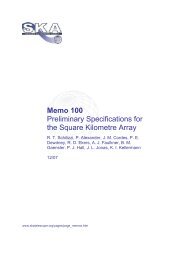REQUIREMENTS DOCUMENT FOR SKA SIGNAL PROCESSING
REQUIREMENTS DOCUMENT FOR SKA SIGNAL PROCESSING
REQUIREMENTS DOCUMENT FOR SKA SIGNAL PROCESSING
Create successful ePaper yourself
Turn your PDF publications into a flip-book with our unique Google optimized e-Paper software.
<strong>REQUIREMENTS</strong> <strong>DOCUMENT</strong> <strong>FOR</strong><strong>SKA</strong> <strong>SIGNAL</strong> <strong>PROCESSING</strong>Document number .................................................................. WP2‐040.030.011‐TD‐001Revision ........................................................................................................................... 1Author ............................................................................................................... W.TurnerDate ................................................................................................................. 2011‐03‐30Status .............................................................................................. Approved for releaseName Designation Affiliation Date SignatureAdditional AuthorsSubmitted by:W. Turner Signal ProcessingDomain SpecialistSPDO 2011‐03‐26Approved by:T.Stevenson System Engineer SPDO 2011‐03‐29
WP2‐040.030.011‐TD‐001Revision : 1<strong>DOCUMENT</strong> HISTORYRevision Date Of Issue Engineering ChangeNumberCommentsA ‐ ‐ First draft release for internal reviewBCD 30 th March 2011 Updated to reflect comments from T.Stevenson1 30 th March 2011 First Issue<strong>DOCUMENT</strong> SOFTWAREPackage Version FilenameWordprocessor MsWord Word 2007 07‐WP2‐040.030.000.SRS‐001‐1_<strong>SKA</strong>SPReqSpecBlock diagramsOtherORGANISATION DETAILSNamePhysical/PostalAddress<strong>SKA</strong> Program Development OfficeJodrell Bank Centre for AstrophysicsAlan Turing BuildingThe University of ManchesterOxford RoadManchester, UKM13 9PLFax. +44 (0)161 275 4049Website www.skatelescope.org2011‐03‐30 Page 2 of 96
WP2‐040.030.011‐TD‐001Revision : 1TABLE OF CONTENTS1 INTRODUCTION ............................................................................................. 81.1 Purpose of the document ....................................................................................................... 82 REFERENCES ................................................................................................ 93 REQUIREMENT STRUCTURE OVERVIEW ............................................................. 103.1 Requirement ID ..................................................................................................................... 113.2 Requirement Description ...................................................................................................... 113.3 Verification Method .............................................................................................................. 123.4 Priority ................................................................................................................................... 123.5 Status .................................................................................................................................... 133.6 Phase ..................................................................................................................................... 133.7 Originator .............................................................................................................................. 133.8 Date ....................................................................................................................................... 133.9 Rationale and Assumptions .................................................................................................. 134 <strong>SIGNAL</strong> <strong>PROCESSING</strong> <strong>REQUIREMENTS</strong> HIERACHY ................................................. 144.1 Definition Phase .................................................................................................................... 144.2 Signal Processing Element .................................................................................................... 154.2.1 General Description ...................................................................................................... 154.2.2 External Interfaces ........................................................................................................ 164.2.2.1 Environment .............................................................................................................. 164.2.2.2 Simulator ................................................................................................................... 164.2.2.3 Receptors .................................................................................................................. 164.2.2.4 RFI Database ............................................................................................................. 164.2.2.5 VLBI ........................................................................................................................... 164.2.2.6 Power ........................................................................................................................ 174.2.2.7 Cooling ...................................................................................................................... 174.2.2.8 External Transient Triggers ....................................................................................... 174.2.2.9 Time Reference ......................................................................................................... 174.2.2.10 Science Computing ................................................................................................ 174.2.2.11 Monitoring and Control ........................................................................................ 175 <strong>SIGNAL</strong> <strong>PROCESSING</strong> ELEMENT <strong>REQUIREMENTS</strong> .................................................. 185.1.1 Pulsar Search ................................................................................................................. 185.1.2 Pulsar Timing ................................................................................................................. 195.1.3 Instantaneous Bandwidth ............................................................................................. 205.1.4 Number, width and placement of station output bands .............................................. 222011‐03‐30 Page 3 of 96
WP2‐040.030.011‐TD‐001Revision : 15.1.5 Spectral Resolution ....................................................................................................... 225.1.6 Channelisation .............................................................................................................. 235.2 <strong>SKA</strong> 1 Sensitivity and Survey requirements ............................................................................ 255.2.1 Survey speed ................................................................................................................. 255.2.2 Survey ‘On‐Sky’ time ..................................................................................................... 255.2.3 Deep Field Integration Time.......................................................................................... 255.3 Baseline requirements .......................................................................................................... 255.4 Temporal characteristics ....................................................................................................... 265.4.1 Central Beamformer Main beam stability .................................................................... 265.4.2 Spatial side‐lobe stability .............................................................................................. 265.4.3 Beam‐switching agility .................................................................................................. 265.4.4 Frequency switching agility ........................................................................................... 275.5 Polarisation characteristics ................................................................................................... 285.6 RFI avoidance ........................................................................................................................ 295.7 Imaging characteristics ......................................................................................................... 305.7.1 Instantaneous field of view ........................................................................................... 305.7.2 Pointing accuracy .......................................................................................................... 315.8 Monitoring and Control (M&C) Function .............................................................................. 315.8.1 Top‐level requirements ................................................................................................. 315.8.2 Control requirements .................................................................................................... 385.8.3 Monitoring requirements ............................................................................................. 405.9 Data Acquisition Characteristics ........................................................................................... 425.10 Observational Modes ............................................................................................................ 425.10.1 Top level modes ............................................................................................................ 426 OPERATIONAL <strong>REQUIREMENTS</strong> ....................................................................... 446.1 General .................................................................................................................................. 446.2 Routine operations ............................................................................................................... 456.3 Start‐up and shutdown ......................................................................................................... 456.4 Failure management ............................................................................................................. 496.4.1 General .......................................................................................................................... 496.4.2 Detection and reporting ................................................................................................ 526.4.3 Diagnosis and recovery ................................................................................................. 536.4.4 Lifetime ......................................................................................................................... 566.5 Maintenance ......................................................................................................................... 576.6 Disposal phase ...................................................................................................................... 637 DESIGN CONSTRAINTS .................................................................................. 637.1 Environmental Requirements ............................................................................................... 637.1.1 General .......................................................................................................................... 637.1.2 Site and infrastructure requirements ........................................................................... 637.1.3 Contamination .............................................................................................................. 657.1.4 Radio Frequency Interference ...................................................................................... 667.1.5 Electro Magnetic Compatibility..................................................................................... 667.1.6 Self‐generated RFI environment ................................................................................... 672011‐03‐30 Page 4 of 96
WP2‐040.030.011‐TD‐001Revision : 17.1.7 Lightning ........................................................................................................................ 687.1.8 Grounding ..................................................................................................................... 687.1.9 Corrosion ....................................................................................................................... 697.1.10 Seismicity ...................................................................................................................... 707.1.11 Other Aspects ................................................................................................................ 707.2 Engineering Design Constraints ............................................................................................ 717.2.1 General .......................................................................................................................... 717.2.2 Size and weight ............................................................................................................. 717.2.3 Materials and Processes ............................................................................................... 727.2.4 Marking ......................................................................................................................... 747.2.5 Power and other utilities .............................................................................................. 777.3 Quality Factors Requirements .............................................................................................. 777.3.1 General .......................................................................................................................... 787.3.2 Workmanship ................................................................................................................ 787.3.3 System Safety ................................................................................................................ 807.3.4 Security ......................................................................................................................... 817.3.5 Reliability ....................................................................................................................... 817.3.6 Maintainability .............................................................................................................. 817.3.7 Flexibility and upgradability .......................................................................................... 827.3.8 Accessibility and testability ........................................................................................... 837.3.9 Transportability and storage ......................................................................................... 837.3.10 Life ................................................................................................................................. 858 INTERFACE <strong>REQUIREMENTS</strong> ............................................................................ 858.1 External Interfaces ................................................................................................................ 858.1.1 Power ............................................................................................................................ 858.1.2 Cooling .......................................................................................................................... 878.1.3 Time Reference ............................................................................................................. 888.1.4 Science and Computing ................................................................................................. 898.1.5 Monitoring and Control ................................................................................................ 908.1.6 Maintainer ..................................................................................................................... 918.1.7 Engineer ........................................................................................................................ 918.1.8 Environment .................................................................................................................. 918.1.9 Simulator ....................................................................................................................... 918.1.10 Sparse AA ...................................................................................................................... 928.1.11 Dish ............................................................................................................................... 928.2 Internal Interfaces ................................................................................................................. 928.2.1 Power ............................................................................................................................ 928.3 Synchronization ..................................................................................................................... 939 SUPPORT <strong>REQUIREMENTS</strong> ............................................................................. 939.1 Maintenance ......................................................................................................................... 939.2 Logistics ................................................................................................................................. 9310 EXTENSIBILITY <strong>REQUIREMENTS</strong> .................................................................... 942011‐03‐30 Page 5 of 96
WP2‐040.030.011‐TD‐001Revision : 110.1 Extension interfaces .............................................................................................................. 9410.2 Extension performance ......................................................................................................... 9511 QUALITY ASSURANCE PROVISIONS ............................................................... 9511.1 System Qualification testing ................................................................................................. 9511.2 Test Methods ........................................................................................................................ 96LIST OF FIGURESFigure 1 Requirement Context .............................................................................................................. 10Figure 2 Requirement Structure ........................................................................................................... 11Figure 3 Requirements Hierarchy ......................................................................................................... 14Figure 4 Signal Processing Context Diagram ......................................................................................... 15No table of figures entries found.LIST OF TABLES2011‐03‐30 Page 6 of 96
WP2‐040.030.011‐TD‐001Revision : 1LIST OF ABBREVIATIONSAA .................................. Aperture ArrayAnt. ................................ AntennaCoDR ............................. Conceptual Design ReviewDRM .............................. Design Reference MissionEoR ............................... Epoch of ReionisationEX .................................. ExampleFLOPS ........................... Floating Point Operations per secondFoV ................................ Field of ViewLNA ............................... Low Noise AmplifierNy .................................. NyquistOH ................................. Over HeadOTPF ............................. Observing Time Performance FactorOv .................................. Over samplingPAF ............................... Phased Array FeedPrep<strong>SKA</strong>........................ Preparatory Phase for the <strong>SKA</strong>RFI ................................. Radio Frequency Interferencerms ................................ root mean squareSEFD...........................System Equivalent Flux Density<strong>SKA</strong> ............................... Square Kilometre Array<strong>SKA</strong>DS .......................... <strong>SKA</strong> Design StudiesSPDO ............................ <strong>SKA</strong> Program Development OfficeSSFoM .......................... Survey Speed Figure of MeritTBD ............................... To be decidedWrt ................................. with respect to2011‐03‐30 Page 7 of 96
1 IntroductionWP2‐040.030.011‐TD‐001Revision : 1The aim of this document is to present the requirement breakdown of the Signal Processing aspectsof the <strong>SKA</strong> telescope for Phase 1 with extensibility to Phase 2 of the project. This is document ispart of a series generated in support of the Signal Processing CoDR which includes the following:Signal Processing High Level DescriptionTechnology RoadmapDesign Concept DescriptionsSignal Processing RequirementsSignal Processing CostsSignal Processing Risk RegisterSignal Processing Strategy to Proceed to the Next PhaseStrategy to Proceed to the next phaseSoftware Firmware StrategyThe focus of this Requirements document is providing an initial step towards providing a completeset of traceable Element level requirements and their associated attributes. To achieve this, theinitial System level requirements are flowed down and complemented with additional SignalProcessing specific requirements.This document provides a strategy for the presentation of requirements and associated attributesthat is intended to create unambiguous requirements with an expectation that the requirements willeventually be imported into a requirements management tool. Further work is required to refine therequirements and this will be the objective for the SRS review1.1 Purpose of the documentThe purposes of this document are as follows:• Provide a high level guiding statement as to the purpose of the <strong>SKA</strong> Signal ProcessingIdentify the Stakeholders associated with the Signal Processing aspects of the <strong>SKA</strong>State the Mandated ConstraintsIdentify naming conventions for the requirementsProvide an overview of the requirement structure and life cycle.To present the Signal Processing Element and Subsystem requirementsIdentify attributes associated with requirementsProvide a traceability matrix to identify the parent requirement within the system hierarchy2011‐03‐30 Page 8 of 96
WP2‐040.030.011‐TD‐001Revision : 12 References[1] <strong>SKA</strong> Science Case[2] The Square Kilometre Array Design Reference Mission: <strong>SKA</strong>‐mid and <strong>SKA</strong>‐Lo v 0.4[3] Science Operations Plan[4] System Interfaces[5] Environmental requirements (natural and induced)[6] <strong>SKA</strong> strategies and philosophies[7] Risk Register[8] Requirements Traceability[9] Logistic Engineering Management Plan (LEMP)[10] Risk Management Plan (RMP)[11] Document Handling Procedure[12] Project Dictionary[13] Strategy to proceed to the next phase[14] WP3 <strong>SKA</strong> array configuration report[15] WP3 <strong>SKA</strong> site RFI environment report[16] WP3 Troposphere measurement campaign report[17] <strong>SKA</strong> Science‐Technology Trade‐off Process (WP2‐005.010.030‐MP‐004)[18] A. Faulkner, et al., Aperture Arrays for the <strong>SKA</strong>: the <strong>SKA</strong>DS White Paper, January 2010.[19] E. de Lera‐Acedo et al., System Noise Analysis of an Ultra Wide Band Aperture Array: <strong>SKA</strong>DSMemo T28.[20] <strong>SKA</strong> Monitoring and Control Strategy WP2‐005.065.000‐R‐001 Issue Draft E[21] “The Square Kilometre Array”, Peter E. Dewdney, Peter J. Hall, Richard T. Schilizzi, and T.Joseph L. W. Lazio, Proceedings of the IEEE Vol. 97,No. 8, August 2009[22] Thompson, A. R., Moran, J. M., and Swenson, G. W. “Interferometry and Aperture Synthesisin Radio Astronomy” (second edition), Wiley, 1986.[23] System Engineering Management Plan (SEMP) WP2‐005.010.030‐MP‐001Reference 3[24] <strong>SKA</strong> System Requirement Specification (SRS)[25] <strong>SKA</strong> IP Policy Document[26] International Technology Roadmap for Semiconductors (ITRS), available at www.itrs.net.2011‐03‐30 Page 9 of 96
WP2‐040.030.011‐TD‐001Revision : 13 Requirement Structure OverviewStakeholderPlays a role inIs ownned byPriorityScenarioGoalHas importanceOccurs insatisfiesInterfaceConnects toMeasurementVerifiesRequirementIs justified byRationaleDefinitionDefines a term inHas sub-typeFunction Quality ConstraintFigure 1 Requirement ContextFigure 1 provides a context of the requirements that is applicable within all layers of the systemhierarchy. The interconnecting lines define the association between the blocks in the diagram. Forexample there are three sub types of requirement:Functional: A functional requirement is to define what is to be doneQuality: A quality requirement is to change the way something is done. Quality requirementsinclude: safety, security, reliability, performance, maintainability, and environment.Constraint: Constraints are restrictions or limitations on possible solutions. For the <strong>SKA</strong> themostEach of these requirements is to satisfy a goal owned by a particular stakeholder that plays a role ina role in a scenario of the system. Scenarios are associated with the modes and configurations ofthe system and define the dynamic behaviour. This document includes Use Cases to provide a pathto discovering associated requirements.2011‐03‐30 Page 10 of 96
WP2‐040.030.011‐TD‐001Revision : 1bdd [block] system [Requirement definitions]«block»Requirement«block»RequirementID«block»VerificationMethod«block»Status«block»Owner«block»Originator«block»TraceabilityLinks«block»RequirementDescription«block»Priority«block»Phase«block»Rationale«block»Date«block»User Type«block»Result Type«block»Object«block»QualifierFigure 2 Requirement StructureAs detailed in Figure 2 a requirement comprises of more information the just the requirementdescription. This information in effect forms attributes for the requirement.3.1 Requirement IDThe Requirement ID provides a unique identifier for each individual requirement. The RequirementID takes the form:_REQ_xxxxThe sting provides a unique descriptor identifying the item within the systems hierarchy that therequirement set is applicable toxxxx is a four digit decimal number uniquely identifying the requirement within the requirement set.For example:“SYS_REQ_0010” identifies the first requirement at the systems level.3.2 Requirement DescriptionThe requirement description has to be clear, concise and verifiable:The requirement should be a single active sentence as short as possible.The requirement should focus on naming a single desired resultEvery requirement should be verifiableRequirements should avoid conjunctions such as: “and”, “or”, “with” and “also” as thesetend to wrap multiple requirements into one which is not desirable.2011‐03‐30 Page 11 of 96
WP2‐040.030.011‐TD‐001Revision : 1Requirements should not specify the design envelope.The anatomy of the requirement should contain:User type:Result Type:Object:Qualifier:A noun identifying the beneficiary of the requirementA verb identifying the action of the requirementThe object that the verb is applicable toAdverbal phrase identifying the desirable result of the actionAn example:The call centre operator shall be able to view details of the protected household within two secondsof issuing the queryUser type:Result Type:Object:Qualifier:The call centre operatorshall be able to viewdetails of the protected householdwithin two seconds of issuing the query3.3 Verification MethodAs stated in the requirement description, all requirements are to be verifiable. The method ofverification is to be attached as an attribute to the requirement. The method of verification shouldbe one of the following:InspectionTestDemonstrationAnalysisSimulation3.4 PriorityThe priority of the requirement is to be attached as an attribute to the requirement. The priorityshould be identified by one of the following:EssentialUsefulInteresting2011‐03‐30 Page 12 of 96
WP2‐040.030.011‐TD‐001Revision : 1Luxury3.5 StatusRequirements are not static statements but have a life‐cycle. The status within the life‐cycle shouldbe identified by one of the following:ProposedReviewedAcceptedRejectedTo be modified3.6 PhaseWhether the requirement is applicable to Phase 1 or phase 2 of the <strong>SKA</strong> should be identified by anattribute associated with the requirement: Phase 1 Phase 23.7 OriginatorThe originator of the requirement should be attached as an attribute.3.8 DateThe date that the requirement was created should be attached as an attribute.3.9 Rationale and AssumptionsMaking assumptions explicit and connecting them to an argued rationale enables decisions to be revisitedwithout starting all over again.An understanding of rationale enables accurate prioritisation and is an aid to preventing essentialrequirements from being deleted.2011‐03‐30 Page 13 of 96
4 Signal Processing Requirements HierachyWP2‐040.030.011‐TD‐001Revision : 1The requirements for signal processing form part of the overall system hierarchy as illustrated inFigure 3.<strong>SKA</strong> UserUserRequirementFeedbackProgramEngineeringInstallation& ValidationOperationsSupportTelescopeSystemSystemRequirementSystemArchitecturalDesignFeedbackProductEngineeringInstallation&VerificationIntegratedSystemElementElementRequirementPartitionElementArchitecturalDesignFeedbackProductEngineeringInstallation&VerificationIntegratedElementSub-systemSub-systemRequirementPartitionSub-SystemArchitecturalDesignFeedbackProductEngineeringInstallation&VerificationIntegratedSub-SystemAssemblySub-AssemblyAssemblyRequirementSub-AssemblyRequirementPartitionPartitionAssemblyArchitecturalDesignFeedbackSub-AssyArchitecturalDesignProductEngineeringProductEngineeringInstallation&VerificationInstallation&VerificationIntegratedAssemblyIntegratedSub-AssemblyComponentComponentSpecificationComponentDesign Build& TestComponentsPartPartSpecificationFigure 3 Requirements HierarchyEach level in the hierarchy has its own set of requirements which are derived from the nexthierarchical level above. There is also a feedback path via the architectural design process to informthe requirements at the higher level whether there are any issues. The flow‐down and feedback isan on‐going process iterating towards a stable and eventually base‐lined requirement set.The initial requirements for the concept phase of Signal Processing element level is the scope of thisdocument. It identifies the subset of concept phase system requirements that are applicable tosignal processing and presents additional requirements where there are gaps. This process formspart of an iterative feedback path to the system level.CoDR in the definition phase where activities will refine these requirements so that they can beutilised by each of the Signal Processing Sub‐Systems4.1 Definition PhaseThe aim of the definition phase is primarily to perform requirements analysis and validation toensure that the complete set of requirements is understood and is present. Gaps will be identified2011‐03‐30 Page 14 of 96
WP2‐040.030.011‐TD‐001Revision : 1and actions to address these shortcomings will be initiated. The result of these activities will becaptured in the relevant Requirement Specifications to be reviewed at the conclusion of this phase.Architectural design activities will also be initiated with the aim of producing a first draft designdocument at the end of the phase.Interfaces will be refined and finalised as far as possible (especially functional interfaces).This phase will be concluded by the (Sub) System Requirements Review (SRR).4.2 Signal Processing Element4.2.1 General Descriptionbdd [package] Context [Signal processing context]Simulator0..*EnvironmentEngineerMaintainerMonitoring &ControlOperator0..*ReceptorsDigitisedRF + RFI«System»Signal ProcessingScientistProcessed DataScienceComputingRFI Database0..*1..*VLBIPowerCoolingExternalTransientTriggersTimeReferenceFigure 4 Signal Processing Context DiagramThe aim of Figure 4is to identify the complete set of external and user systems that interface to theSignal Processing domain. External systems are treated as black boxes and are represented by a 3‐Dbox in the diagram. User systems provide a mechanism for user interaction and typically includekeyboards displays etc. The User System is also presented as a 3‐D box in the diagram but is inassociation with a ‘stick‐man’ symbol representing the actor.The lines connecting blocks within the diagram represent associations between the blocks. Withinthe Figure 4 context, these associations are largely based on flows between the blocks. Flows are notlimited to data exchange but can include physical entities such as fluids or electrical current. Theflows don’t have to be atomic: for example the receptors provide a flow of digitised RF datacombined with RFI Data.2011‐03‐30 Page 15 of 96
WP2‐040.030.011‐TD‐001Revision : 1The multiplicity of an item is provided at the ends of the association lines. For example there arezero to any number of External Transient Triggers or Simulators and 1 to any number of TimeReferences. Where a multiplicity isn’t provided it is to be assumed to be unity.4.2.2 External Interfaces4.2.2.1 EnvironmentOverall environmental conditions for the telescope including temperature, humidity, shock,vibration, particle and wildlife ingress. The strategy for this is addressed in the EnvironmentalRequirements (Natural and Induced) document [5]The signal processing will be housed in a temperature and humidity controlled environments thatare readily accessible to maintenance.4.2.2.2 SimulatorIs the simulator inside the Signal Processing boundary?4.2.2.3 ReceptorsThe RF signal is the wanted signal from the astronomical source being observed. The DesignReference Mission [2] defines the performance envelope for the telescope.RF Interference represents any external contaminating RF signal. This is site dependent and isdetailed in WP3 <strong>SKA</strong> site RFI environment report [15].4.2.2.4 RFI DatabaseThe RFI data base will contain data on known RFI sources and detail their frequency and positioncharacteristics as a function of time. Information from the data base is utilised by the SignalProcessing to flag data streams that could potentially be contaminated with RFI.4.2.2.5 VLBIThe VLBI Data Interface Specification Release 1.0 ratified 26 th June 2009 specifies the standardizedtransport‐independent VLBI data‐interchange format that is suitable for all types of VLBI datatransfer, including real‐time and near‐real‐time e‐VLBI well as disk‐file storage.http://www.vlbi.org/vsi/docs/VDIF%20specification%20Release%201.0%20ratified.pdfThe complementary physical interface specification is currently being written.Although the VDIF specification makes no mention of data‐transport protocol, it has been developedwith an awareness of expected methods of data transport, including network transport using variousstandard protocols, as well as physical or electronic transport of standard disk files.2011‐03‐30 Page 16 of 96
WP2‐040.030.011‐TD‐001Revision : 14.2.2.6 PowerExternal power to the system is dealt with in the Power section of the Strategies and Philosophiesdocument [6].4.2.2.7 CoolingThe strategy for dealing with cooling for the <strong>SKA</strong> telescope is detailed in the Cooling section of theStrategies and Philosophies document [6].4.2.2.8 External Transient TriggersThe <strong>SKA</strong> telescope is to provide the facility for receiving external transient triggers. The interface isto utilise the SkyAlert service (http://www.skyalert.org/ ) (TBC) which collects and distributesastronomical events in near‐real time and distributes the resultant data in accordance to theprovisional standard VOevent (http://www.ivoa.net/Documents/REC/VOE/VOEvent‐20061101.html). The transient events include supernovae, gamma‐ray bursts, micro‐lensing .4.2.2.9 Time ReferenceIt is anticipated that this will be satellite GPS and is detailed in the Timing and Synchronisationsection of the <strong>SKA</strong> Strategies and Philosophies document [6].4.2.2.10 Science ComputingAn Interface Control Document is required to define the interface between Signal Processing andScience Computing. This will comprise of:Data Exchange SpecificationPhysical Interface document4.2.2.11 Monitoring and ControlMonitoring includes output from the telescope to the operator. This will provide information on thehealth status and the configuration of the telescope and is detailed in the Monitoring and ControlStrategies and Philosophies document [22].External operator control of the telescope is detailed in the Science Operations Plan [3] and theMonitoring and Control Strategies and Philosophies document [22].2011‐03‐30 Page 17 of 96
WP2‐040.030.011‐TD‐001Revision : 15 Signal Processing Element Requirements5.1.1 Pulsar SearchIdent Requirement Status Parent VerificationSP_REQ_0010The signal processing shall be capableof performing an all sky survey withintwo years.Proposed SYS_REQ_1420 AnalysisIdent Requirement Status Parent VerificationSP_REQ_0020The pulsar search shall have a timeresolution of 50μs or lessProposed SYS_REQ_1620 TestIdent Requirement Status Parent VerificationSP_REQ_0030Spectral Resolution The pulsar searchshall have a frequency resolution of20 kHzProposed SYS_REQ_TBD TestThis is the reciprocal of the time resolution. Currently no parent requirementIdent Requirement Status Parent VerificationSP_REQ_0040The pulsar search shall be capable ofcompensating for time delays due tothe intergalactic medium fordispersion measures up to 2400 cm ‐3pc TBCProposedSYS_REQ_1620SYS_REQ_TBDTestDerived from 3 GHz, instantaneous bandwidth and time resolution.Ident Requirement Status Parent VerificationSP_REQ_0050The pulsar search shall be capable ofdetecting ms pulsars to an equivalentluminosity of 0.1 mJy kpc 2 at 1.4 GHzTBCProposed SYS_REQ_TBD TestThe luminosity for this requirement is taken from the DRM. However the frequency at which it isapplicable is assumed to be 1.4 GHz.2011‐03‐30 Page 18 of 96
WP2‐040.030.011‐TD‐001Revision : 1Ident Requirement Status Parent VerificationSP_REQ_0060The pulsar search shall be capable ofdetecting binary pulsar with linearacceleration range of +/‐ 100 ms ‐2 TBCProposed SYS_REQ_TBD TestNon parent requirementIdent Requirement Status Parent VerificationSP_REQ_0070The pulsar search processing chainshall have a signal to noise betterthan TBD dBProposed SYS_REQ_TBD AnalysisNo parent requirement5.1.2 Pulsar TimingIdent Requirement Status Parent VerificationSP_REQ_0080 The signal processing for pulsartiming shall have a time resolution of100ns or lessProposed SYS_REQ_1620 TestSYS_REQ_1620 should specify 100ns not 100μsIdent Requirement Status Parent VerificationSP_REQ_0090The pulsar timing processing chainshall have a signal to noise betterthan TBD dBProposed SYS_REQ_TBD AnalysisIdent Requirement Status Parent VerificationSP_REQ_0100The pulsar timing processing chainshall be capable of switching theobservation frequency in less than 10minutesProposed SYS_REQ_1670 TestNo parent requirement2011‐03‐30 Page 19 of 96
WP2‐040.030.011‐TD‐001Revision : 1Ident Requirement Status Parent VerificationSP_REQ_0110Pulsar pulse arrival times shall bemeasured to an absolute timeaccurate to TBDProposed SYS_REQ_TBD TestNo parent requirementIdent Requirement Status Parent VerificationSP_REQ_0120 Signal processing shall have thecapability of storing pulsar pulseprofile templatesProposed SYS_REQ_TBD TestNo parent requirementIdent Requirement Status Parent VerificationSP_REQ_0130The signal processing shall providethe capability of timing TBD pulsarssimultaneously in real timeProposed SYS_REQ_TBD TestNo parent requirement5.1.3 Instantaneous BandwidthIdent Requirement Status Parent VerificationSP_REQ_0140Signal Processing shall be capable ofreal time correlation processing foran instantaneous bandwidth, of 500MHz for the range 70 MHz – 600 MHz(TBV)Proposed SYS_REQ_1120 Test2011‐03‐30 Page 20 of 96
WP2‐040.030.011‐TD‐001Revision : 1Ident Requirement Status Parent VerificationSP_REQ_0150Signal Processing shall be capable ofreal time Non‐Imaging processing foran instantaneous bandwidth, of 500MHz for the range 70 MHz – 600 MHz(TBV)Proposed SYS_REQ_1120 TestIdent Requirement Status Parent VerificationSP_REQ_0160SP shall be capable of real timecorrelation processing for aninstantaneous bandwidth, of 1 GHzfor the range 600 MHz – 3 1 GHz (TBV)Proposed SYS_REQ_1120 TestIdent Requirement Status Parent VerificationSP_REQ_0170Signal Processing shall be capable ofreal time Non‐Imaging processing foran instantaneous bandwidth, of 1GHz for the range 600 MHz – 3 GHz(TBV)Proposed SYS_REQ_1120 TestIdent Requirement Status Parent VerificationSP_REQ_0180The signal processing shall be capableof correlation processing for aninstantaneous band anywhere withinthe operating frequency band.Proposed SYS_REQ_1130 TestIdent Requirement Status Parent VerificationSP_REQ_0190 Band selection resolution. Theresolution with which the 500 MHzand 1 GHz bands can be selected shallbe TBD or less.Proposed SYS_REQ_1140 Test1 Note that the Phase 1 System requirements specify 10 GHz which is incorrect2011‐03‐30 Page 21 of 96
WP2‐040.030.011‐TD‐001Revision : 15.1.4 Number, width and placement of station output bandsIdent Requirement Status Parent VerificationSP_REQ_0200 Sub‐band bandwidth. Thebandwidth after station levelbeamforming shall be less than TBDHz.Proposed SYS_REQ_1160 TestThe sub‐band bandwidth has differing requirements for imaging and non‐imaging processing. Nonimagingsub‐band width shouldn’t be finer than the reciprocal of the required time resolution.Ident Requirement Status Parent VerificationSP_REQ_0210DSP signal processing capacity. Thedigital processing capacity shall besufficient to process all sub‐bands forall beams and polarizations.Proposed SYS_REQ_1170 TestHowever , the number of sub‐bands needs to be determined by the requirements of the processing.Consequently, this is a circular requirement?Ident Requirement Status Parent VerificationSP_REQ_0220Beam sub‐band and channel phaserelations. The phase relationsbetween the sub‐bands and channelswithin a beam shall be known to sucha precision that wider bands andcorresponding time series can bereconstructed from sub‐bands and/orchannels.Proposed SYS_REQ_1180 Test5.1.52 Spectral ResolutionIdent Requirement Status Parent VerificationSP_REQ_0230Spectral resolution. <strong>SKA</strong>1 shall offer aspectral resolution in eachpolarization for image processing of
WP2‐040.030.011‐TD‐001Revision : 1Ident Requirement Status Parent VerificationSP_REQ_0240Spectral resolution. <strong>SKA</strong>1 shall offer aspectral resolution in eachpolarization for image processing of
WP2‐040.030.011‐TD‐001Revision : 1Ident Requirement Status Parent VerificationSP_REQ_0280 Stop‐band ripple. Channelisationshall have stop band ripple < TBD dBin the band 1.4 GHz to3GHzProposed SYS_REQ_1230 TestIdent Requirement Status Parent VerificationSP_REQ_0290Pass‐band ripple. Channelisation shallhave pass band ripple < TBD dB in theband 70MHz to 240 MHzProposed SYS_REQ_1230 TestIdent Requirement Status Parent VerificationSP_REQ_0300Pass‐band ripple. Channelisation shallhave pass band ripple < TBD dB in theband 200 MHz to1.4 GHzProposed SYS_REQ_1230 TestIdent Requirement Status Parent VerificationSP_REQ_0310Pass‐band ripple. Channelisation shallhave pass band ripple < TBD dB in theband 1.4 GHz to3 GHzProposed SYS_REQ_1230 TestIdent Requirement Status Parent VerificationSP_REQ_0320Channel overlap. Individual channelsgenerated by channelization shall nothave components of > TBD dB inadjacent frequency channelsProposed SYS_REQ_1230 Test2011‐03‐30 Page 24 of 96
WP2‐040.030.011‐TD‐001Revision : 15.2 <strong>SKA</strong> 1 Sensitivity and Survey requirements5.2.1 Survey speedIdent Requirement Applicability Parent VerificationSurvey speed. The <strong>SKA</strong> 1 survey speedrequirement is:SYS_REQ_1410~10 7 m 4 K ‐2 deg 2 for the frequency range200MHz to 1.4 GHzMandatory>10 7 m 4 K ‐2 deg 2 Mandatory5.2.2 Survey ‘On‐Sky’ timeIdent Requirement Applicability Parent VerificationThe <strong>SKA</strong> Phase 1 shall be designed sothat a major survey can be completed in2 years of “on‐sky” observation time.SYS_REQ_1420Analysis5.2.3 Deep Field Integration TimeIdent Requirement Applicability Parent VerificationThe <strong>SKA</strong> Phase 1 shall be designed sothat a deep field can be completed in1000 hr of integration time.MandatorySYS_REQ_1430Analysis5.3 Baseline requirementsIdent Requirement Status Parent VerificationSP_REQ_0360 Delay compensation The signalprocessing shall compensate forsignal transmission delays fromreceptors to signal processing facilitywith a resolution of one time sampleProposed SYS_REQ_1510 Test2011‐03‐30 Page 25 of 96
WP2‐040.030.011‐TD‐001Revision : 1Ident Requirement Status Parent VerificationSP_REQ_0370Baseline. The signal processing shallprovide correlation for baselines upto and including 200 kmProposed SYS_REQ_1510 Test5.4 Temporal characteristics5.4.1 Central Beamformer Main beam stabilityIdent Requirement Status Parent VerificationSP_REQ_0380Main beam stability. The magnitudeand phase variations of any <strong>SKA</strong> 1compound beam over a 12 hoursperiod at any point of its half‐powercontour shall be less than 1% (TBC)relative to the beam peak.Proposed SYS_REQ_1610 Test5.4.2 Spatial side‐lobe stabilityIdent Requirement Status Parent VerificationSP_REQ_0390 Spatial side‐lobe stability. Spatialside lobes should be stable to withinTBD.Proposed TBD Test5.4.3 Beam‐switching agilityIdent Requirement Status Parent VerificationSP_REQ_0400Beam former weight update rate.Changing the beam pointing shall bepossible every 60 seconds (TBC) in thecase of scheduled switchingsequences.Proposed SYS_REQ_1640 Test2011‐03‐30 Page 26 of 96
WP2‐040.030.011‐TD‐001Revision : 1Ident Requirement Status Parent VerificationSP_REQ_0410Beam former weight ad‐hoc updateresponse time. Changing the beamformer weights shall be possiblewithin 60 seconds in case of changesdue to manual interaction or changesin schedule.Proposed SYS_REQ_1650 TestIdent Requirement Status Parent VerificationSP_REQ_0420Beam‐switching downtime flagging.Observation data (specify: bothuv(w)‐data and tied array beams)acquired during a change of beamdirection shall be flagged.Proposed SYS_REQ_1660 Test5.4.4 Frequency switching agilityIdent Requirement Status Parent VerificationSP_REQ_0440 Switching between observationfrequencies. The signal processingshall be able to ‘switch betweenobserving frequencies within 10minutes or less’Proposed SYS_REQ_1670 TestIdent Requirement Status Parent VerificationSP_REQ_0450Integration buffers. All associatedsignal processing data buffers shall bereset to default values for changes inobservation frequencyProposed SYS_REQ_1670 Test2011‐03‐30 Page 27 of 96
WP2‐040.030.011‐TD‐001Revision : 1Ident Requirement Status Parent VerificationSP_REQ_0460Observation frequency meta data.The signal processing shall providemeta data in association with dataproducts including observationfrequency.Proposed SYS_REQ_1670 Test5.5 Polarisation characteristicsIdent Requirement Status Parent VerificationSP_REQ_0470 Beam polarisation stability. Thepolarization properties of the beamsshall be stable enough to allow theircalibration to better than 0.5% (TBC)Proposed SYS_REQ_1710 TestIt is envisioned that most of the factors affecting the polarisation stability are in the analogue anddigitisation domains. However signal processing needs to ensure polarisation channel pairs aretightly coupled with respect to delay compensation, beamformer coefficients, data truncation etc. toensure that no systematic errors are introducedIdent Requirement Status Parent VerificationSP_REQ_0480Beam polarisation stability. Externalcalibration measurements shall benecessary at a rate of no more thanonce per hour (TBC).Proposed SYS_REQ_1710 TestIdent Requirement Status Parent VerificationSP_REQ_0490 Stokes parameters. <strong>SKA</strong>1 shallprovide visibility data in all fourStokes parameters.Proposed SYS_REQ_1730 Test2011‐03‐30 Page 28 of 96
WP2‐040.030.011‐TD‐001Revision : 1Ident Requirement Status Parent VerificationSP_REQ_0500 Instrumental polarisation Thepolarisation introduced by theinstrument, after calibration, shall beless than 0.5% of the total intensity.(TBC)Proposed SYS_REQ_1740 Test5.6 RFI avoidanceIdent Requirement Status Parent VerificationSP_REQ_0510The signal processing shall utiliseinformation from an RFI data base toflag potentially contaminatedfrequency channelsProposedSYS_REQ_1810Ident Requirement Status Parent VerificationSP_REQ_0520Integrated auto correlation productsshall be generated on all channelizeddata streamsProposedSYS_REQ_1810Ident Requirement Status Parent VerificationSP_REQ_0530The signal processing shall provideRFI threshold detection on integratedauto correlation products for allchannelized dataProposedSYS_REQ_1810Ident Requirement Status Parent VerificationSP_REQ_0540The signal processing shall provideRFI threshold detection on integratedauto correlation productsProposedSYS_REQ_18102011‐03‐30 Page 29 of 96
WP2‐040.030.011‐TD‐001Revision : 1Ident Requirement Status Parent VerificationSP_REQ_0550It shall be possible to set the RFIdetection threshold on allchannelized data channelsProposedSYS_REQ_1810Ident Requirement Status Parent VerificationSP_REQ_0560 Off stream processing for thecalculation of RFI detectionthresholds shall be provided by thesignal processingProposedSYS_REQ_1810Ident Requirement Status Parent VerificationSP_REQ_0570The <strong>SKA</strong>1 shall have limited (TBD)susceptibility to bursty/spiky RFI (forpulsars, transients)ProposedSYS_REQ_1810Ident Requirement Status Parent VerificationSP_REQ_0580 Historic, time stamped thresholddetections shall be made available forpotential inclusion in the RFI databaseProposedSYS_REQ_1810To be expanded …5.7 Imaging characteristics5.7.1 Instantaneous field of viewIdent Requirement Status Parent VerificationSP_REQ_0600 The Sparse AA correlator shallbe capable of simultaneouslyprocessing signals in real time for afield of view greater than 5 degrees.’ProposedSYS_REQ_19102011‐03‐30 Page 30 of 96
WP2‐040.030.011‐TD‐001Revision : 1Ident Requirement Status Parent VerificationSP_REQ_0610The signal processing shall make allcross correlation products availableto the Science computingProposedSYS_REQ_19205.7.2 Pointing accuracyThe mechanical and electronic pointing accuracy requirements of the dishes and the AAs are listedbelow.Ident Requirement Status Parent VerificationSP_REQ_0620 Beam forming coefficient. Thecoefficients used for the generationof beams in the central beamformershall have a data width of TBD bitsProposedSYS_REQ_1950SYS_REQ_1960SYS_REQ_1970SYS_REQ_1980Ident Requirement Status Parent VerificationSP_REQ_0630 Beam forming coefficient. Thecoefficients used for the generationof Dish beams in the centralbeamformer shall be updated everyTBD minutesProposedSYS_REQ_1950SYS_REQ_1960SYS_REQ_1970SYS_REQ_19805.8 Monitoring and Control (M&C) FunctionMonitoring and Control is a central system responsible for acquiring monitoring data and for controlof the <strong>SKA</strong>1 systems. It has a level of autonomy and its sub‐systems are distributed to local areas.5.8.1 Top‐level requirementsIdent Requirement Status Parent VerificationSP_REQ_0640M&C. Signal Processing shall providemonitoring and control functionalityProposedSYS_REQ_2110Ident Requirement Status Parent Verification2011‐03‐30 Page 31 of 96
SP_REQ_0650 M&C. It shall be possible toelectronically read each signalprocessing Line Replaceable Unit’s ,serial number through the <strong>SKA</strong>1 M&CsystemProposedWP2‐040.030.011‐TD‐001Revision : 1SYS_REQ_2110Ident Requirement Status Parent VerificationSP_REQ_0660 M&C. It shall be possible toelectronically read each signalprocessing Line Replaceable Unit’slocation through the <strong>SKA</strong>1 M&CsystemProposedSYS_REQ_2110Ident Requirement Status Parent VerificationSP_REQ_0670M&C. Where applicable, it shall bepossible to electronically read eachsignal processing Line ReplaceableUnit’s firmware version through the<strong>SKA</strong>1 M&C systemProposedSYS_REQ_2110Ident Requirement Status Parent VerificationSP_REQ_0680M&C. Where applicable, it shall bepossible to electronically read eachsignal processing Line ReplaceableUnit’s Operation System typethrough the <strong>SKA</strong>1 M&C systemProposedSYS_REQ_2110Ident Requirement Status Parent VerificationSP_REQ_0690M&C. Where applicable, it shall bepossible to electronically read eachsignal processing Line ReplaceableUnit’s Operation System versionthrough the <strong>SKA</strong>1 M&C systemProposedSYS_REQ_21102011‐03‐30 Page 32 of 96
WP2‐040.030.011‐TD‐001Revision : 1Ident Requirement Status Parent VerificationSP_REQ_0700M&C. Where applicable, it shall bepossible to electronically read eachsignal processing Line ReplaceableUnit’s Memory Usage through the<strong>SKA</strong>1 M&C systemProposedSYS_REQ_2110Ident Requirement Status Parent VerificationSP_REQ_0710M&C. Where applicable, it shall bepossible to electronically read eachsignal processing Line ReplaceableUnit’s percentage processing usagethrough the <strong>SKA</strong>1 M&C systemProposedSYS_REQ_2110Ident Requirement Status Parent VerificationSP_REQ_0720M&C. Where applicable, it shall bepossible to electronically read eachsignal processing Line ReplaceableUnit’s operating voltages through the<strong>SKA</strong>1 M&C systemProposedSYS_REQ_2110Ident Requirement Status Parent VerificationSP_REQ_0730M&C. Where applicable, it shall bepossible to electronically read eachsignal processing Line ReplaceableUnit’s thermal dissipation throughthe <strong>SKA</strong>1 M&C systemProposedSYS_REQ_2110Ident Requirement Status Parent VerificationSP_REQ_0740M&C. Where applicable, it shall bepossible to electronically read eachsignal processing Line ReplaceableUnit’s temperature through the<strong>SKA</strong>1 M&C systemProposedSYS_REQ_21102011‐03‐30 Page 33 of 96
WP2‐040.030.011‐TD‐001Revision : 1Ident Requirement Status Parent VerificationSP_REQ_0750 M&C. Historic signal processingM&C system data shall be stored localto the signal processingProposedSYS_REQ_2110Ident Requirement Status Parent VerificationSP_REQ_0760 M&C. Historic signal processingdata shall be made available to themain M&C on requestProposedSYS_REQ_2110Ident Requirement Status Parent VerificationSP_REQ_0770M&C. It shall be possible to setthresholds on monitored parametersProposedSYS_REQ_2110Ident Requirement Status Parent VerificationSP_REQ_0780 M&C. If monitored parameterthresholds are traversed in eitherdirection the signal processing systemshall inform the <strong>SKA</strong>1 M&C system.ProposedSYS_REQ_2110Ident Requirement Status Parent VerificationSP_REQ_0790M&C. Signal Processing Monitor andcontrol computer nodes shall utiliseDHCP to obtain their addressProposedSYS_REQ_2110Ident Requirement Status Parent VerificationSP_REQ_0800M&C. Signal Processing Monitor andcontrol computer nodes shall utiliseDNS to obtain their nameProposedSYS_REQ_21102011‐03‐30 Page 34 of 96
WP2‐040.030.011‐TD‐001Revision : 1Ident Requirement Status Parent VerificationSP_REQ_0810M&C. Signal Processing Monitor andcontrol computer nodes shall timestamp all M&C messagesProposedSYS_REQ_2110Ident Requirement Status Parent VerificationSP_REQ_0820 M&C. Time stamps for SignalProcessing Monitor and Controlmessages shall be accurate to TBD msProposedSYS_REQ_2110Ident Requirement Status Parent VerificationSP_REQ_0830 M&C. All monitor and controlcomputer nodes shall be passwordprotectedProposedSYS_REQ_2110Ident Requirement Status Parent VerificationSP_REQ_0840M&C. All passwords on monitor andcontrol computer nodes shall beencryptedProposedSYS_REQ_2110Ident Requirement Status Parent VerificationSP_REQ_0850M&C purpose. The monitoring andcontrol function shall ensure that allparts of the system work togethercoherently. All control functions,except certain local maintenancefunctions, are part of the M&Csystem.ProposedSYS_REQ_2120Ident Requirement Status Parent VerificationSP_REQ_0860M&C. All signal processing equipmentshall implement Power on Self Test,POSTProposedSYS_REQ_21302011‐03‐30 Page 35 of 96
WP2‐040.030.011‐TD‐001Revision : 1Ident Requirement Status Parent VerificationSP_REQ_0870M&C. All signal processing equipmentshall implement Built in Self Test, BITProposedSYS_REQ_2130Ident Requirement Status Parent VerificationSP_REQ_0880M&C. POST results from individualLRUs shall be made available to the<strong>SKA</strong>1 M&C on requestProposedSYS_REQ_2130This is not always the case for COTs computing nodes that often provide POST indications throughLED flash sequences or audible beeps.Ident Requirement Status Parent VerificationSP_REQ_0890M&C. BIT results from individual LRUsshall be made available to the <strong>SKA</strong>1M&C on requestProposedSYS_REQ_2130Ident Requirement Status Parent VerificationSP_REQ_0900M&C autonomy. The monitoring andcontrol function shall takeautonomous action to amelioratefailures where possible and support afail‐safe philosophy.ProposedSYS_REQ_2140Ident Requirement Status Parent VerificationSP_REQ_0910M&C transparency The M&C shallprovide a hierarchical and redundantsyslogProposedSYS_REQ_21602011‐03‐30 Page 36 of 96
WP2‐040.030.011‐TD‐001Revision : 1Ident Requirement Status Parent VerificationSP_REQ_0920 M&C remote operation. Themonitoring and control function shallbe designed to operate theinstrument fully remotely.ProposedSYS_REQ_2190Ident Requirement Status Parent VerificationSP_REQ_0930M&C communication nodes. Thesignal processing monitoring andcontrol shall use a separate physicalinterface from the main applicationcommunication.ProposedSYS_REQ_2190Ident Requirement Status Parent VerificationSP_REQ_0940M&C performance monitoring. Themonitoring and control function shallprovide TBD performance monitoringdata to users.ProposedSYS_REQ_2210Ident Requirement Status Parent VerificationSP_REQ_0950M&C monitoring data. All <strong>SKA</strong>1subsystems shall provide monitoringdata to the monitoring and controlfunction (for performance monitoringand closed‐loop control functions)ProposedSYS_REQ_2220Ident Requirement Status Parent VerificationSP_REQ_0960M&C logging. The monitoring andcontrol function shall provide for along‐term logging sub‐function withworkflow support for the OperationalTeam and with sufficient informationto relate system events to artefacts inthe data.ProposedSYS_REQ_22302011‐03‐30 Page 37 of 96
WP2‐040.030.011‐TD‐001Revision : 1Ident Requirement Status Parent VerificationSP_REQ_0970M&C observation interrupts. It shallbe possible to abort an observation ifmonitor parameters exceed userspecified limits (including RFImitigation performance indicationparameters).ProposedSYS_REQ_2240Ident Requirement Status Parent VerificationSP_REQ_0980 M&C calibration information.Individual element calibrationinformation shall be available to themeasurement function.ProposedSYS_REQ_2250The requirements on the M&C function related to Health and Safety still needs to be analysed,verified and added.5.8.2 Control requirementsRequirements regarding control of the instrument (configuration of beam forming, correlation etc)Ident Requirement Status Parent VerificationSP_REQ_0990Control system. Control informationfor the signal processing shall bereceived over the <strong>SKA</strong>1 M&C networkProposedSYS_REQ_2310Ident Requirement Status Parent VerificationSP_REQ_1000 Control synchronisation. Controlchanges received by the Signalprocessing shall take in accountlatencies due to processing andcommunication pipelines beforebeing appliedProposedSYS_REQ_23102011‐03‐30 Page 38 of 96
WP2‐040.030.011‐TD‐001Revision : 1Ident Requirement Status Parent VerificationSP_REQ_1010 Control handshake. The signalprocessing shall provideacknowledgement to received controlmessagesProposedSYS_REQ_2310Ident Requirement Status Parent VerificationSP_REQ_1020 Control handshake. The signalprocessing shall provideacknowledgement that controlupdates have been successfully actedonProposedSYS_REQ_2310Ident Requirement Status Parent VerificationSP_REQ_1030 Control system autonomy. Thecontrol system shall be capable ofautonomously calculating systemsettings in response to changes ininstrument status, environment ormeasurement results.ProposedSYS_REQ_2320Ident Requirement Status Parent VerificationSP_REQ_1040System settings activation. It shall bepossible to activate the calculatedsystem settings automaticallyProposedSYS_REQ_2330Ident Requirement Status Parent VerificationSP_REQ_1050System settings activation. It shall bepossible to activate the calculatedsystem settings after explicitconfirmation by the operator (manualcontrol).ProposedSYS_REQ_23302011‐03‐30 Page 39 of 96
WP2‐040.030.011‐TD‐001Revision : 1Ident Requirement Status Parent VerificationSP_REQ_1060System setting activation autonomy.It shall be possible to specify whensettings should be activatedautomatically and when they need tobe confirmed by the operator.ProposedSYS_REQ_2340Ident Requirement Status Parent VerificationSP_REQ_1070Schedule update. It shall be possibleto receive and accept updatedschedules before the end‐time of thecurrently active schedule has expired.ProposedSYS_REQ_23505.8.3 Monitoring requirementsRequirements regarding monitoring the status of the instrument (configuration and health)Ident Requirement Status Parent VerificationSP_REQ_1080 Monitoring data consolidation.Signal processing shall hierarchicallyconsolidate monitoring informationto produce high‐level monitoringinformation from low‐levelmonitoring information.ProposedSYS_REQ_2410Ident Requirement Status Parent VerificationSP_REQ_1090Monitoring data consolidation. Itshall be possible for the <strong>SKA</strong>1 M&C toaccess individual layers within theconsolidated monitoring hierarchyProposedSYS_REQ_24102011‐03‐30 Page 40 of 96
WP2‐040.030.011‐TD‐001Revision : 1Ident Requirement Status Parent VerificationSP_REQ_1100 Subsystem‐M&C action reports.Subsystems shall report completionof actions to M&CProposedSYS_REQ_2420Ident Requirement Status Parent VerificationSP_REQ_1110M&C summary reports. It shall bepossible for all user roles(specification of these roles TBD) toproduce summarized historicalmonitoring information.ProposedSYS_REQ_2430Ident Requirement Status Parent VerificationSP_REQ_1120 Control data augmentation. Theresults of control actions shall beverified with measurements madeexpressly for the purpose.ProposedSYS_REQ_2440Ident Requirement Status Parent VerificationSP_REQ_1130If the normal measurement sequencedoes not provide for controlverification in a timely fashion, suchmeasurements shall be made out ofsequence.ProposedSYS_REQ_2440Ident Requirement Status Parent VerificationSP_REQ_1140 Monitoring informationconsolidation. It shall be possible toconsolidate monitoring informationboth on the physical instrumentstatus and on designated logicalconcepts like observation, correlator.ProposedSYS_REQ_24502011‐03‐30 Page 41 of 96
WP2‐040.030.011‐TD‐001Revision : 1Ident Requirement Status Parent VerificationSP_REQ_1150 Monitoring informationconsolidation. The signal processingshall have procedures to ensure logfiles do not fill disk partitions.ProposedSYS_REQ_24505.9 Data Acquisition CharacteristicsThis section describes the functions in the acquisition and initial processing path. This includes thedefinition of observation modes (synthesis imaging, tied array, fly’s eye, pulsar detection) and ofintermediate and final data products. Also the functional and performance requirements for RFImitigation, the data transport network and some derived performance parameters for data handlingare listed here.To be expanded.5.10 Observational ModesThis section identifies the top‐level observational modes.5.10.1 Top level modesIdent Requirement Status Parent VerificationSP_REQ_1160Synthesis imaging mode. <strong>SKA</strong>1 shallprovide a synthesis imaging modewhere compound beams arecorrelated to form visibilitiesProposedSYS_REQ_2710Ident Requirement Status Parent VerificationSP_REQ_1170Visibilities. The signal processing shallbe able to handle the full data streamfrom the dishes in synthesis imagingmode.ProposedSYS_REQ_27202011‐03‐30 Page 42 of 96
WP2‐040.030.011‐TD‐001Revision : 1Ident Requirement Status Parent VerificationSP_REQ_1171Visibilities. The signal processing shallbe able to handle the full data streamfrom the Sparse AAs in synthesisimaging mode.ProposedSYS_REQ_2720Ident Requirement Status Parent VerificationSP_REQ_1180 Tied array mode. The signalprocessing shall provide a tied arraymode where the signals from allreceptors are transformed back intotime series for pulsar processing.ProposedSYS_REQ_2730Ident Requirement Status Parent VerificationSP_REQ_1190Fly’s eye mode. The signal processingshall provide a fly’s eye mode (TBC).ProposedSYS_REQ_2740Ident Requirement Status Parent VerificationSP_REQ_1191Fly’s eye mode. In fly’s eye modeAutocorrelations of all single dishesare recorded.ProposedSYS_REQ_2740Each dish is tracking a different position on the sky. This doesn’t appear to be a phase 1requirement.Ident Requirement Status Parent VerificationSP_REQ_1192Fly’s eye mode. In fly’s eye modeAutocorrelations of all aperture(sub)arrays are recorded.ProposedSYS_REQ_2740Each sub‐array is tracking a different position on the sky. This doesn’t appear to be a phase 1requirement.2011‐03‐30 Page 43 of 96
WP2‐040.030.011‐TD‐001Revision : 1Ident Requirement Status Parent VerificationSP_REQ_1200Aggregate mode. <strong>SKA</strong>1 shall providean aggregate mode in whichbandwidth is exchanged for spatialcoverage in the correlator.ProposedSYS_REQ_2750Is this a phase 1 requirement ?Ident Requirement Status Parent VerificationSP_REQ_1210 Real‐time calibration. <strong>SKA</strong>1 shallprovide instrumental real‐timecalibration functions in allobservational modes.ProposedSYS_REQ_27606 Operational Requirements6.1 GeneralThis section states general operational requirements.Ident Requirement Status Parent VerificationSP_REQ_1220Up‐time. The signal shall have anavailability of TBD.ProposedSYS_REQ_3110Ident Requirement Status Parent VerificationSP_REQ_1230Remote M&C from sites. It shall bepossible for the operator to controland monitor the <strong>SKA</strong>1 instrumentfrom the <strong>SKA</strong> station sites and coresite.ProposedSYS_REQ_31302011‐03‐30 Page 44 of 96
WP2‐040.030.011‐TD‐001Revision : 1Ident Requirement Status Parent VerificationSP_REQ_1240Physical access security. The systemshall provide security to preventunauthorized physical access tofacilities and resources.ProposedSYS_REQ_3140To be added: security measures for other aspects such as network access, server access, encryptionof M&C messages.6.2 Routine operationsThis section gives system level requirements for the routine operations of <strong>SKA</strong> 1 .Ident Requirement Status Parent VerificationSP_REQ_1250Reconfiguration time. Under normaloperation, econfiguration of <strong>SKA</strong>1from one observational mode toanother shall not take longer than 5minutes (TBC)ProposedSYS_REQ_31506.3 Start‐up and shutdownThis section gives system level requirements for <strong>SKA</strong> 1 start‐up and shutdown, including check‐out atinitialization.Ident Requirement Status Parent VerificationSP_REQ_1260Full remote control. It shall bepossible to control all <strong>SKA</strong>1 functionsfrom the operational centre, withoutrequiring physical access to theinstrument, including start‐up andshut down.ProposedSYS_REQ_31602011‐03‐30 Page 45 of 96
WP2‐040.030.011‐TD‐001Revision : 1Ident Requirement Status Parent VerificationSP_REQ_1270Full remote control. It shall bepossible to control signal processingfunctions from the operationalcentre.ProposedSYS_REQ_3160Ident Requirement Status Parent VerificationSP_REQ_1280Full remote control. It shall bepossible to control signal processingstart‐up from the operational centre.ProposedSYS_REQ_3160Ident Requirement Status Parent VerificationSP_REQ_1290Full remote control. It shall bepossible to control signal processingshut‐down from the operationalcentre.ProposedSYS_REQ_3160Ident Requirement Status Parent VerificationSP_REQ_1300Full remote control. It shall bepossible to power‐cycle individualsignal processing equipment from theoperational centre.ProposedSYS_REQ_3160Ident Requirement Status Parent VerificationSP_REQ_1310Start‐up sequence. The start‐up ofSignal Processing functions shallfollow a pre‐defined sequenceProposedSYS_REQ_31702011‐03‐30 Page 46 of 96
WP2‐040.030.011‐TD‐001Revision : 1Ident Requirement Status Parent VerificationSP_REQ_1320Start‐up sequence. The hot start(restart) of Signal Processingfunctions shall be less than 10minutesProposedSYS_REQ_3170Ident Requirement Status Parent VerificationSP_REQ_1330Start‐up sequence. The cold start ofSignal Processing functions shall beless than 24 hoursProposedSYS_REQ_3170To be added: definition of hot and cold start.Ident Requirement Status Parent VerificationSP_REQ_1340Shut‐down sequence. The shutdownof <strong>SKA</strong>1 shall follow a pre‐definedsequenceProposedSYS_REQ_3190Ident Requirement Status Parent VerificationSP_REQ_1350Shut‐down sequence. The shutdownof <strong>SKA</strong>1 shall be less than TBDminutes. <strong>SKA</strong>1 shall also have anemergency shut‐down for wind(stowing dishes), lightning, andelectric power anomalies.ProposedSYS_REQ_3190Ident Requirement Status Parent VerificationSP_REQ_1360 Shut‐down sequence. The signalprocessing shall also have aprocedure for emergency shut‐down.ProposedSYS_REQ_31902011‐03‐30 Page 47 of 96
WP2‐040.030.011‐TD‐001Revision : 1Ident Requirement Status Parent VerificationSP_REQ_1370 Shut‐down sequence. The signalprocessing shall provide battery backupto allow sufficient time for orderlyshutdown of operating systems.ProposedSYS_REQ_3190Ident Requirement Status Parent VerificationSP_REQ_1380 Shut‐down sequence. The signalprocessing shall have a procedure forrebuilding disks due to uncontrolledshutdownProposedSYS_REQ_3190Ident Requirement Status Parent VerificationSP_REQ_1390 Start‐up and shut‐downdependencies. Any dependencies inthe start‐up and shutdown sequencesshall be automatically verified (sothey do not depend on operatorintervention).ProposedSYS_REQ_3220Ident Requirement Status Parent VerificationSP_REQ_1400Subsystem shut‐down. The shutdownof pre‐defined parts of the <strong>SKA</strong>1system shall have no (TBC) impact on<strong>SKA</strong>1 operations after appropriate recalibrationperformed automatically.ProposedSYS_REQ_3230Ident Requirement Status Parent VerificationSP_REQ_1410The signal processing M&C systemshall report subsystem health statusProposedSYS_REQ_32402011‐03‐30 Page 48 of 96
WP2‐040.030.011‐TD‐001Revision : 1Ident Requirement Status Parent VerificationSP_REQ_1420The signal processing LRUs shallprovide LED health status indicatorsProposedSYS_REQ_3240Ident Requirement Status Parent VerificationSP_REQ_1430Power on Self Test shall not takelonger to complete than 5 minutesProposedSYS_REQ_3250Ident Requirement Status Parent VerificationSP_REQ_1440The signal processing shall recoverfrom a hot swap within TBD minutes.ProposedSYS_REQ_TBDIdent Requirement Status Parent VerificationSP_REQ_1450Hot swap of a LRUs shall not disruptthe signal processing beyond the unitand its immediate neighboursProposedSYS_REQ_TBD6.4 Failure management 46.4.1 GeneralGeneral requirements regarding failure managementIdent Requirement Status Parent VerificationSP_REQ_1460Personnel safety. As far as possible,no single failure in the <strong>SKA</strong>1 shall leadto personnel safety hazards.ProposedSYS_REQ_33104 Section still to be aligned with Logistic Engineering Management Plan.2011‐03‐30 Page 49 of 96
WP2‐040.030.011‐TD‐001Revision : 1Ident Requirement Status Parent VerificationSP_REQ_1470Failure propagation. Failures in oneof the signal processing subsystemsshall not lead to failures in other <strong>SKA</strong>1subsystems.ProposedSYS_REQ_3320Ident Requirement Status Parent VerificationSP_REQ_1480Operator command safety. No singleoperator command shall causecatastrophic, serious, or majorconsequences.ProposedSYS_REQ_3330Ident Requirement Status Parent VerificationSP_REQ_1490Voltage transients consequences. Novoltage‐transients shall lead tocatastrophic or serious consequences.ProposedSYS_REQ_3340Ident Requirement Status Parent VerificationSP_REQ_1500Voltage transients consequences. No"cut‐off" of electrical power shall leadto catastrophic or seriousconsequences.ProposedSYS_REQ_3340Ident Requirement Status Parent VerificationSP_REQ_1510Operator command absence. Theabsence of operator commands shallnot cause catastrophic or seriousconsequences.ProposedSYS_REQ_33502011‐03‐30 Page 50 of 96
WP2‐040.030.011‐TD‐001Revision : 1Ident Requirement Status Parent VerificationSP_REQ_1520 Single‐point failures. Single‐pointfailuresin the design shall be listed.ProposedSYS_REQ_3360Ident Requirement Status Parent VerificationSP_REQ_1520 Single‐point failure justification.Each‐single‐point failure in the designshall be justified, and assessedagainst alternative design(s) wherethis single‐point‐failure would notoccur.ProposedSYS_REQ_3370Ident Requirement Status Parent VerificationSP_REQ_1530Single‐point failure watchdog. Thecorrect functioning of each singlepoint‐failurein the design shall bemonitored by a watchdog function.ProposedSYS_REQ_3380Ident Requirement Status Parent VerificationSP_REQ_1540Failing equipment. Failing equipmentshall not provide data (TBC).ProposedSYS_REQ_3410This requirement is impossible to verify and it is probably not achievableIdent Requirement Status Parent VerificationSP_REQ_1550Failing equipment. Failing equipmentshall flag a ‘failed’ status via M&ChierarchyProposedSYS_REQ_3410Whether the failed status can be flagged will depend on the nature of the failure.2011‐03‐30 Page 51 of 96
WP2‐040.030.011‐TD‐001Revision : 1Ident Requirement Status Parent VerificationSP_REQ_1560Failing equipment. Failing equipmentshall not flood the M&C system withstatus messagesProposedSYS_REQ_3410Ident Requirement Status Parent VerificationSP_REQ_1570 Failing equipment The controlfunction shall take appropriatemeasures for failing equipment.ProposedSYS_REQ_34106.4.2 Detection and reportingRequirements regarding failure detecting equipment and how failures are to be reported includinglevel of detection.Ident Requirement Status Parent VerificationSP_REQ_1580Status report availability time. Thestatus report of the functioning of asubsystem shall be available in 5seconds from request.ProposedSYS_REQ_3520Ident Requirement Status Parent VerificationSP_REQ_1590Status report request. The statusreport of a subsystem shall reflect thefunctioning of the subsystem at orafter the operator request has beensubmitted to the system.ProposedSYS_REQ_35302011‐03‐30 Page 52 of 96
WP2‐040.030.011‐TD‐001Revision : 1Ident Requirement Status Parent VerificationSP_REQ_1600 Status report scope. The statusreport shall display the status of afunction, together with the systemtime the status was determined.ProposedSYS_REQ_35406.4.3 Diagnosis and recoveryRequirements regarding distinguishing of failures and how failures are to be recovered fromIdent Requirement Status Parent VerificationSP_REQ_1610Autonomous and manual controlmodes. The signal processing shallhave the capability to be operated byan operator in an autonomous modeProposedSYS_REQ_3620Ident Requirement Status Parent VerificationSP_REQ_1620Autonomous and manual controlmodes. The signal processing shallhave the capability to be operated byan operator in a manual controlmode.ProposedSYS_REQ_3620Ident Requirement Status Parent VerificationSP_REQ_1630Autonomous malfunctioning actions.In autonomous mode, allmalfunctioning equipment shall beswitched off autonomouslyProposedSYS_REQ_36302011‐03‐30 Page 53 of 96
WP2‐040.030.011‐TD‐001Revision : 1Ident Requirement Status Parent VerificationSP_REQ_1640Autonomous malfunctioning actions.In autonomous mode, allmalfunctioning equipment shall beswitched off autonomouslyProposedSYS_REQ_3630Ident Requirement Status Parent VerificationSP_REQ_1650Autonomous switch off. Details of allactions taken in autonomous modeshall be recorded in the system logProposedSYS_REQ_3630Ident Requirement Status Parent VerificationSP_REQ_1660Autonomous switch off. Details of allactions taken in autonomous modeshall be brought to the attention ofthe operatorProposedSYS_REQ_3630Ident Requirement Status Parent VerificationSP_REQ_1670Manual control switch on/off. In themanual control mode, the operatorshall have the capability to switch onor off all signal processing equipmentProposedSYS_REQ_3640Ident Requirement Status Parent VerificationSP_REQ_1680Operator actions logging. Operatoractions on the signal processing shallbe recorded in the systems log‐file.ProposedSYS_REQ_36502011‐03‐30 Page 54 of 96
WP2‐040.030.011‐TD‐001Revision : 1Ident Requirement Status Parent VerificationSP_REQ_1690 Operator actions logging. Signalprocessing status changes as a resultof operator actions shall be recordedin the systems log‐file.ProposedSYS_REQ_3650Ident Requirement Status Parent VerificationSP_REQ_1700Recovery actions. It shall be possibleto take recovery actions withoutconsequences for other parts of<strong>SKA</strong>1.ProposedSYS_REQ_3660Ident Requirement Status Parent VerificationSP_REQ_1710 Recovery actions the signalprocessing shall minimize impact ofrecovery actions.ProposedSYS_REQ_3660Ident Requirement Status Parent VerificationSP_REQ_1720 Autonomous recovery. Signalprocessing shall be able to recoverautonomously in case of failures thatare classified as minor or negligible.ProposedSYS_REQ_3670Ident Requirement Status Parent VerificationSP_REQ_1730Effect of disabled units. The signalprocessing design shall ensure thatdisabled units do not corrupt theremaining system.ProposedSYS_REQ_36802011‐03‐30 Page 55 of 96
6.4.4 LifetimeOperational lifetime requirements, including spare parts and supporting equipmentWP2‐040.030.011‐TD‐001Revision : 1Ident Requirement Status Parent VerificationSP_REQ_1740Continuous operation period. Signalprocessing equipment shall bedesigned for a continuous operationalperiod of 6 month.ProposedSYS_REQ_3710After this time maintenance may be necessary, e.g. exchange/cleaning of air‐conditioning filter. Therequirement with respect to ‘continuous operation’. Also ‘designed for’ doesn’t have much meaningfor the final implementation. What degredation of equipment is acceptable?Ident Requirement Status Parent VerificationSP_REQ_1750Minimum life time. <strong>SKA</strong>1 shall bedesigned for a minimum life time ofTBD years, including initialinstallation, testing andcommissioning period.ProposedSYS_REQ_3720Ident Requirement Status Parent VerificationSP_REQ_1760Availability. The average availabilityof the signal processing elementduring the operational period shall bebetter than 90% (TBC).ProposedSYS_REQ_3730Availability is defined here as being available for scheduled observations in at least one of thesupported operational modes.Ident Requirement Status Parent VerificationSP_REQ_1770Upgradeability The signal processingelement’s subsystems shall beupgradable.ProposedSYS_REQ_37402011‐03‐30 Page 56 of 96
WP2‐040.030.011‐TD‐001Revision : 1Ident Requirement Status Parent VerificationSP_REQ_1780 Life‐time extension. Large scalemaintenance and/or an upgrade shallgive the possibility to reach a life timeof 50 years (TBC).ProposedSYS_REQ_37506.5 Maintenance 5Requirements regarding maintenance concept, corrective and preventiveIdent Requirement Status Parent VerificationSP_REQ_1790All signal processing boards shall behot swappableProposedSYS_REQ_TBDIdent Requirement Status Parent VerificationSP_REQ_1800All bolts shall be held in place withcaptive nutsProposedSYS_REQ_TBDIdent Requirement Status Parent VerificationSP_REQ_1810 All cables ends shall carryidentificationProposedSYS_REQ_TBDIdent Requirement Status Parent VerificationSP_REQ_1820 All connector plates shall carryidentification labels for connectorsProposedSYS_REQ_TBD5 Section still to be aligned with Logistic Engineering Management Plan.2011‐03‐30 Page 57 of 96
WP2‐040.030.011‐TD‐001Revision : 1Ident Requirement Status Parent VerificationSP_REQ_1830Where appropriate, connectors shallbe polarisedProposedSYS_REQ_TBDIdent Requirement Status Parent VerificationSP_REQ_1840Full fail rate. The signal processingshall fully fail less than two times peryear (TBC),Proposed SYS_REQ_3810 AnalysisThe number is determined as average over its operational period. Note: Full failure is defined hereas an unscheduled inability to operate in any observational mode for more than two hours due tomalfunctioning of one or more subsystems. The requirement applies to the period after initialcommissioning of the system or any upgraded components.Ident Requirement Status Parent VerificationSP_REQ_1850Repair period. The MTTR for anysignal processing LRU shall be lessthan 1 week (TBC).ProposedSYS_REQ_3820Here, a failure is defined as not being able to meet the scientific specifications due to (sub)systemfailure(s). MTTR = Mean Time To RepairIdent Requirement Status Parent VerificationSP_REQ_1860 Non‐availability information. Allusers with scheduled measurementsduring the failure period shall beinformed of the non‐availability ofsignal processing sub‐systemsProposedSYS_REQ_38302011‐03‐30 Page 58 of 96
WP2‐040.030.011‐TD‐001Revision : 1Ident Requirement Status Parent VerificationSP_REQ_1870Batteries. Where possible, the use ofbattery backup on PCBs shall beavoidedProposedSYS_REQ_3830Computer and servers will typically have batteries fitted to keep on board clocks etc powered. Thesebatteries have a limited lifeIdent Requirement Status Parent VerificationSP_REQ_1880Batteries. A policy for maintainingbatteries on spares shall be identifiedProposedSYS_REQ_3830Ident Requirement Status Parent VerificationSP_REQ_1890Data loss due to power outage. Allsubsystems shall not lose more than 4hours of acquired or processedmeasurement data (not yetpermanently stored) as a result of anoutage in the external power supply.ProposedSYS_REQ_3840Ident Requirement Status Parent VerificationSP_REQ_1900Autonomous restart after poweroutage. All subsystems shall have thecapability to restart autonomouslyand without failures, after an outagein external power supply.ProposedSYS_REQ_3850Ident Requirement Status Parent VerificationSP_REQ_1910System availability after restart. Allsubsystems shall be available within 5minutes after restart (TBC).ProposedSYS_REQ_3860(Note – there may be subsystems that may not comply to the requirement and will need to behandled differently. Hard disk rebuilds for example will take longer than 5 minutes).2011‐03‐30 Page 59 of 96
WP2‐040.030.011‐TD‐001Revision : 1Ident Requirement Status Parent VerificationSP_REQ_1920 Software/firmware re‐installation.All software/firmware in the signalprocessing element shall allow its reinstallation.ProposedSYS_REQ_3870Ident Requirement Status Parent VerificationSP_REQ_1930 Software/firmware re‐installation.All signal processing equipment shallprovide front panel interfaces tofacilitate the down load of newsoftware/ firmware.ProposedSYS_REQ_3870Ident Requirement Status Parent VerificationSP_REQ_1940 Software/firmware re‐installation.All signal processing equipment shallprovide front panel interfaces tofacilitate the update of BIOSconfigurations.ProposedSYS_REQ_3870Ident Requirement Status Parent VerificationSP_REQ_1950 Software/firmware re‐installation.All signal processing equipment shallhave standardised front panelinterfaces.ProposedSYS_REQ_3870Ident Requirement Status Parent VerificationSP_REQ_1960Software/firmware re‐installation. Arugged portable PC shall be madeavailable to the maintainter forsoftware and firmware download.ProposedSYS_REQ_38702011‐03‐30 Page 60 of 96
WP2‐040.030.011‐TD‐001Revision : 1Ident Requirement Status Parent VerificationSP_REQ_1970Software/firmware re‐installation. Aserver shall be provided forautomated software and firmwaredownload..ProposedSYS_REQ_3870Ident Requirement Status Parent VerificationSP_REQ_1980 Software/firmware re‐installation.Interfaces for firmware and softwareupdate shall be password protected.ProposedSYS_REQ_3870Ident Requirement Status Parent VerificationSP_REQ_1990 Software/firmware re‐installation.All software, firmware and BIOSconfigurations shall be versioncontrolled.ProposedSYS_REQ_3870Ident Requirement Status Parent VerificationSP_REQ_1200 Software/firmware re‐installation.There shall be a policy for periodicupdates of operating systems andfirmware.ProposedSYS_REQ_3870Ident Requirement Status Parent VerificationSP_REQ_1210 Software/firmware re‐installation.There shall be a policy for periodicupdates of software and firmwareengineering tools.ProposedSYS_REQ_38702011‐03‐30 Page 61 of 96
WP2‐040.030.011‐TD‐001Revision : 1Ident Requirement Status Parent VerificationSP_REQ_1220 Software code identification.Software configuration itemsshall provide unambiguous inputs toallow the maintenance of aconfiguration management database.ProposedSYS_REQ_3890Ident Requirement Status Parent VerificationSP_REQ_1230 Software code identificationresponse time. The softwareidentification shall be available to theoperator within 10 seconds after therequest was made. (TBC)ProposedSYS_REQ_3910Ident Requirement Status Parent VerificationSP_REQ_1240 Software code identificationresponse time. The softwareidentification shall be available to theoperator within 10 seconds after therequest was made. (TBC)ProposedSYS_REQ_3910Ident Requirement Status Parent VerificationSP_REQ_1250Subsystem maintenance functions.All subsystems shall include functionsthat allow maintenance of hardwareand software.ProposedSYS_REQ_39202011‐03‐30 Page 62 of 96
WP2‐040.030.011‐TD‐001Revision : 1Ident Requirement Status Parent VerificationSP_REQ_1290Operating Temperature. All signalprocessing equipment shall have anoperating temperature range of 0 ºCto 35 ºCProposedSYS_REQ_5210Ident Requirement Status Parent VerificationSP_REQ_1300 Storage Temperature. All signalprocessing equipment shall have astorage temperature range of TBDProposedSYS_REQ_5210Ident Requirement Status Parent VerificationSP_REQ_1310 Operating Humidity. All signalprocessing equipment shall have anoperating humidity range of 20% to80%ProposedSYS_REQ_5210Ident Requirement Status Parent VerificationSP_REQ_1320 Storage Humidity. All signalprocessing equipment shall have astorage humidity range of 20% to80%ProposedSYS_REQ_5210Ident Requirement Status Parent VerificationSP_REQ_1330 Condensation. Anti‐condensationheaters shall be fitted to all signalprocessing equipment cabinets (TBC)ProposedSYS_REQ_52102011‐03‐30 Page 64 of 96
WP2‐040.030.011‐TD‐001Revision : 1Ident Requirement Status Parent VerificationSP_REQ_1340Facilities and equipment intrusion.Signal processing equipment facilitiesshall be adequately protected againstintrusion by unauthorized persons.ProposedSYS_REQ_5220Ident Requirement Status Parent VerificationSP_REQ_1350Facilities and equipment intrusion.<strong>SKA</strong>1 equipment facilities shall beadequately protected againstintrusion by “larger” wanderinganimals.ProposedSYS_REQ_52207.1.3 ContaminationIdent Requirement Status Parent VerificationSP_REQ_1360<strong>SKA</strong> signal processing equipment shallbe ISO14644‐1 Class 8 compliant.ProposedSYS_REQ_5240Ident Requirement Status Parent VerificationSP_REQ_1370Signal Processing HVAC systems shallutilise air filtering compliant withMERV 13. (TBC)ProposedSYS_REQ_TBDIdent Requirement Status Parent VerificationSP_REQ_1380Signal Processing facilities shall bemeet ISO Class 8 with respect to airquality.( TBC)ProposedSYS_REQ_TBD2011‐03‐30 Page 65 of 96
7.1.4 Radio Frequency InterferenceWP2‐040.030.011‐TD‐001Revision : 1Protection and measures against interfering signals from outside the instrument. Not applicable tothe <strong>SKA</strong>1 equipment as it is contained within a shielded correlator room7.1.5 Electro Magnetic CompatibilityDuring each phase of the <strong>SKA</strong>1 life, from equipment integration until its end of life, the instrumentshall neither cause disturbance to other systems, nor suffer loss of performance due to othersystems or to the RFI environment.The ability of the <strong>SKA</strong>1 to perform its mission within the required performance shall bedemonstrated by tests, analysis, inspection, verification of records or demonstration according tothe system verification requirements.Ident Requirement Status Parent VerificationSP_REQ_1390EMC safety margin. The EMC safetymargin shall be greater than TBD dB.ProposedSYS_REQ_5610Defined as the ratio between susceptibility threshold and the interference at any point within thesystemIdent Requirement Status Parent VerificationSP_REQ_1400EMC compatibility marking. All "offthe‐shelf"equipment shall posses asa minimum the host country EMCmarkingProposedSYS_REQ_5620Includes electrical and electronic supporting and infrastructural equipment.Ident Requirement Status Parent VerificationSP_REQ_1410 Grounding concept. A hybridgrounding concept as shown infigures TBD shall be used for EMCpurposes.ProposedSYS_REQ_56302011‐03‐30 Page 66 of 96
WP2‐040.030.011‐TD‐001Revision : 1Ident Requirement Status Parent VerificationSP_REQ_1420Grounding concept. Ground loopsinvolving DC, and low frequency AC,currents shall be avoided inside thesystem.ProposedSYS_REQ_5630Ident Requirement Status Parent VerificationSP_REQ_1430 Grounding concept. Intentionalcurrents through structure shall notpermitted. (to be elaborated)ProposedSYS_REQ_5630Ident Requirement Status Parent VerificationSP_REQ_1440Radiated emissions standards. Allsignal processing equipment shall becompliant with FCC Level 2ProposedSYS_REQ_5640Ident Requirement Status Parent VerificationSP_REQ_1450Conducted emissions standards. Allsignal processing equipment shall becompliant with FCC Level 2ProposedSYS_REQ_5640Emission requirements and tests. Emission requirements, both conducted and radiated) and tests(to be elaborated)Susceptibility requirements and tests. Susceptibility requirements and tests (to be elaborated)7.1.6 Self‐generated RFI environmentIdent Requirement Status Parent VerificationSP_REQ_1460The <strong>SKA</strong>1 signal processing shall becontained within a screenedcorrelator room.ProposedSYS_REQ_2910The specification of the correlator room is outside the scope of the signal processing domain2011‐03‐30 Page 67 of 96
7.1.7 LightningWP2‐040.030.011‐TD‐001Revision : 1The first level of suppression of lightning transients is assumed to be implemented as theinfrastructure for central processing facility and remote station equipment housing.Ident Requirement Status Parent VerificationSP_REQ_1470All electrical interfaces to LRUs shallbe protected with high voltagetransient suppressorsProposedSYS_REQ_5730Transorbs or transient suppression diode, TVS. Not that this isn’t the right category for thisrequirementIdent Requirement Status Parent VerificationSP_REQ_1480The number of electrical interfacesacross the boundary of the correlatorroom shall be minimisedProposedSYS_REQ_5730Ident Requirement Status Parent VerificationSP_REQ_1490 Lightning discharge flagging.Observation data taken during alightning strike shall be flagged.ProposedSYS_REQ_57307.1.8 GroundingRequirements regarding grounding of equipment, personnel safety and instrument performance(electrical grounding concept), use of design standardsIdent Requirement Status Parent VerificationSP_REQ_1500 Safety ground. Electrical safetyground shall be designed according tothe regulations imposed by the localgovernment.ProposedSYS_REQ_5810Ident Requirement Status Parent VerificationSP_REQ_1510Safety ground. All equipment handlesshall be earthedProposedSYS_REQ_58102011‐03‐30 Page 68 of 96
WP2‐040.030.011‐TD‐001Revision : 1Ident Requirement Status Parent VerificationSP_REQ_1520Safety ground 0V connectivity. Allequipment shall connect ground tosignal 0V at one point onlyProposedSYS_REQ_5810Need to avoid ground 0V loops. Quite often 0v is connected to ground at individual PCBs7.1.9 CorrosionIdent Requirement Status Parent VerificationSP_REQ_1530Liquid cooling corrosion protection.Any liquid cooling scheme usedwithin the signal processing shallutilise anti‐corrosion additivesProposedSYS_REQ_5820Ident Requirement Status Parent VerificationSP_REQ_1540 Connectors. Harsh environmentconnectors shall be utilised wherecorrosion is considered a riskExample Amphenol 608ProposedSYS_REQ_5820Ident Requirement Status Parent VerificationSP_REQ_1550Corrosion protection in air in areaswith a higher air flow shall beadditionally protected againstcorrosionProposedSYS_REQ_58302011‐03‐30 Page 69 of 96
WP2‐040.030.011‐TD‐001Revision : 17.1.10 SeismicityIdent Requirement Status Parent VerificationSP_REQ_1560Earthquakes. <strong>SKA</strong>1 equipment andbuildings shall be protected againstearthquakes with a magnitude up toRichter 3.8 (TBC).ProposedSYS_REQ_59107.1.11 Other AspectsAdditional aspects that will need consideration in this chapter include:Temperature and humidityo Operationalo Non operational (storage and transportation)Pressureo Operationalo Survival (air transport)Ingress protection (IP rating) of equipment is different areas (exposed, indoors, etc)Dust and sando Exposed equipment against dust stormso Dust ingress into equipment and buildings especially fibre opticsSalt laden atmosphereo Outlying stations close to coastal environmentsVibrationo Operationalo Non operational (transportation of equipment)Shocko Operationalo Non operational (transport of equipment)o Non operational (handling)Solventso Cleaning of equipmentFauna and florao Fungal growtho Animals2011‐03‐30 Page 70 of 96
WP2‐040.030.011‐TD‐001Revision : 17.2 Engineering Design Constraints7.2.1 GeneralIdent Requirement Status Parent VerificationSP_REQ_1570 Deployment locations. The <strong>SKA</strong> 1signal processing equipment shall beinstalled at the <strong>SKA</strong> core siteProposedSYS_REQ_6110Ident Requirement Status Parent VerificationSP_REQ_1580 Deployment locations. The <strong>SKA</strong> 1signal processing equipment shall behoused in the Correlator roomProposedSYS_REQ_6110Note that some aspects of signal processing are covered in other domains. The processing at theSparse AAs is covered by the AAVP and the Dish data acquisition in the DVP. At <strong>SKA</strong>2 dish stationprocessing is included in the Signal Processing domain and will be located in facilities in closeproximity to each dish station.7.2.2 Size and weightIdent Requirement Status Parent VerificationSP_REQ_1590 Lifting hooks. All signal processingequipment weighing more than 40 kgshall be fitted with lifting hooksProposedSYS_REQ_6210The size and weight section of the system requirements would appear to be confined to feedsIdent Requirement Status Parent VerificationSP_REQ_1600 Heavy load labelling. All signalprocessing equipment weighing morethan TBD shall be labelled to TBDstandardProposedSYS_REQ_62102011‐03‐30 Page 71 of 96
WP2‐040.030.011‐TD‐001Revision : 1Ident Requirement Status Parent VerificationSP_REQ_1610Heavy load labelling. All packagingcontaining signal processingequipment weighing more than TBDshall be labelled to TBD standardProposedSYS_REQ_6110Note: this section needs to be expanded.7.2.3 Materials and ProcessesUse is to be made of adequate and (ecological) allowed permissible materials, deviations to beapproved by the project, including management of applied materials.Ident Requirement Status Parent VerificationSP_REQ_1620 Montreal Protocol. The materialswithin in the signal processingequipment shall be compliant withthe Montreal ProtocolAvoids materials that deplete the ozone layerProposedTBDIdent Requirement Status Parent VerificationSP_REQ_1630Halogen Free Cable. Where possiblehalogen free cable shall be used (TBC)ProposedTBDReduces toxicity during a fireIdent Requirement Status Parent VerificationSP_REQ_1640 Materials list. Each sub‐systemsupplier shall provide a Materials listfor all items intended for use in thesignal processing equipmentProposed SYS_REQ_7110 Inspection2011‐03‐30 Page 72 of 96
WP2‐040.030.011‐TD‐001Revision : 1Ident Requirement Status Parent VerificationSP_REQ_1650Hazardous Materials list. Each subsystemsupplier shall provide a list ofhazardous materials used for all itemsintended for use in the signalprocessing equipmentProposed TBD InspectionIdent Requirement Status Parent VerificationSP_REQ_1660Parts list. Each sub‐system suppliershall provide a parts list for all itemsintended for use in the signalprocessing equipmentProposed SYS_REQ_7110 InspectionIdent Requirement Status Parent VerificationSP_REQ_1670 Processes lists. Each sub‐systemsupplier shall provide a process listfor all items intended for use in thesignal processing equipmentProposedSYS_REQ_7110Ident Requirement Status Parent VerificationSP_REQ_1680 Manufacturer’s lists. Allmanufacturer’s lists shall reflect thecurrent design at the time of issue.ProposedSYS_REQ_7110The objectives are the following:a) to ensure that all requirements of the program are met,b) to verify the Materials, Parts and Processes activity of equipment suppliers,c) to control and monitor the status of Materials, Parts and Processes inaccordance with program milestones and regulations2011‐03‐30 Page 73 of 96
WP2‐040.030.011‐TD‐001Revision : 1Ident Requirement Status Parent VerificationSP_REQ_1690 Parts availability. The estimatedavailability of the Parts shall becompatible with the final system’s lifecycleLife cycle includes tests, storage and mission.ProposedSYS_REQ_7130Ident Requirement Status Parent VerificationSP_REQ_1700 Parts availability. The estimatedavailability of products obtained fromMaterials and Processes used shall becompatible with the final system’s lifecycle.(tests, storage, mission)ProposedSYS_REQ_7130Ident Requirement Status Parent VerificationSP_REQ_1710Long lead time items. Long lead timeitems shall be identified to the projectmanagementProposed SYS_REQ_7130 InspectionIdent Requirement Status Parent VerificationSP_REQ_1720 Material environmental rulecompliance. All materials used in the<strong>SKA</strong>1 design shall be fully compliantto all environmental rules applicableto the <strong>SKA</strong>1 core and remote sites.ProposedSYS_REQ_71407.2.4 MarkingComponents, (sub) systems, instruments, equipment, and materials shall be marked forconfiguration control purposes and maintenance support purposes.2011‐03‐30 Page 74 of 96
WP2‐040.030.011‐TD‐001Revision : 1Ident Requirement Status Parent VerificationSP_REQ_1740Part identification. Each part shall bemarked with a unique serial numberProposedSYS_REQ_7210Ident Requirement Status Parent VerificationSP_REQ_1750Part identification. Each LRU typeshall be identified with a uniquedrawing numberProposedSYS_REQ_7210Ident Requirement Status Parent VerificationSP_REQ_1760Marking method. Method of markingshall be compatible with the natureof the item and its use.ProposedSYS_REQ_7220Ident Requirement Status Parent VerificationSP_REQ_1770Marking method. Where possible barcode labelling shall be usedProposedSYS_REQ_7220In addition to identification numbersIdent Requirement Status Parent VerificationSP_REQ_1790Package Marking. All packaging shallbe marked with the part number ofthe contentsProposedSYS_REQ_7220Ident Requirement Status Parent VerificationSP_REQ_1800Package Marking. All packaging shallbe marked with the serial number ofthe contentsProposedSYS_REQ_72202011‐03‐30 Page 75 of 96
WP2‐040.030.011‐TD‐001Revision : 1Ident Requirement Status Parent VerificationSP_REQ_1810 Documentation marking.Identification numbers shall bemarked on documentation and,where possible, on respective items.ProposedSYS_REQ_7230Ident Requirement Status Parent VerificationSP_REQ_1820 All Signal Processing equipmentutilising fibre optic connectivity shallbe labelled with laser hazard warninglabelsProposedTBDIdent Requirement Status Parent VerificationSP_REQ_1830All LRUs with electrostatic sensitivecomponents shall be fitted with ESDwarning labelsProposedTBDIdent Requirement Status Parent VerificationSP_REQ_1840 All packaging containing staticsensitive contents shall be markedwith ESD warning labelsProposedTBDIdent Requirement Status Parent VerificationSP_REQ_1850All items containing communicationports shall be marked with thedefault parameters required foraccessProposedTBD2011‐03‐30 Page 76 of 96
WP2‐040.030.011‐TD‐001Revision : 17.2.5 Power and other utilitiesIdent Requirement Status Parent VerificationSP_REQ_1860Mains supply. The signal processingequipment shall connect to theavailable power distribution withinthe correlator room.ProposedSYS_REQ_7310Ident Requirement Status Parent VerificationSP_REQ_1870 Signal Processing powerconsumption. The total powerconsumption of the <strong>SKA</strong>1 correlatorshall be less than TBD kVA.Need a plan for budgeting the power consumptionProposedSYS_REQ_7330Ident Requirement Status Parent VerificationSP_REQ_1880 Signal Processing powerconsumption. The total powerconsumption of the <strong>SKA</strong>1 Non‐Imaging processor shall be less thanTBD kVA.ProposedSYS_REQ_7330Ident Requirement Status Parent VerificationSP_REQ_1890 Signal Processing powerconsumption. The total powerconsumption of the <strong>SKA</strong>1 CentralBeam‐former shall be less than TBDkVA.ProposedSYS_REQ_73307.3 Quality Factors RequirementsRequirements related to the quality of the product.2011‐03‐30 Page 77 of 96
WP2‐040.030.011‐TD‐001Revision : 17.3.1 GeneralIdent Requirement Status Parent VerificationSP_REQ_1900Quality standard. <strong>SKA</strong>1 equipmentand electronics shall be developedand produced according to theISO9001 quality standard. (TBC)ProposedSYS_REQ_7410<strong>SKA</strong> suppliers should be ISO9001 certifiedIdent Requirement Status Parent VerificationSP_REQ_1910Field return rate. The field return rateof equipment shall be less than 0.5%during installation and the first yearfull usage. (TBC)ProposedSYS_REQ_7420Ident Requirement Status Parent VerificationSP_REQ_1920LRUs of the same type shall beexchangeable within the SignalProcessing SystemProposed SYS_REQ_TBD Demonstration7.3.2 WorkmanshipGood workmanship expected for mechanical, electrical and software production. It refers to thephysical characteristics relating to the level of quality introduced by the manufacturing and assemblyactivities.Ident Requirement Status Parent VerificationSP_REQ_1930 General workmanship standards.General workmanship shall be to thestandard specified in the ProductAssurance Plan (TBD)ProposedSYS_REQ_7510This will cover Software and Hardware production to ISO9001 (TBC).2011‐03‐30 Page 78 of 96
WP2‐040.030.011‐TD‐001Revision : 1Ident Requirement Status Parent VerificationSP_REQ_1940Scope of workmanship standards.<strong>SKA</strong>1 dedicated workmanshipstandards shall be specified inproject dedicated documentsProposed SYS_REQ_7520 InspectionNot sure of the use of the word dedicated in this requirementIdent Requirement Status Parent VerificationSP_REQ_1950 <strong>SKA</strong> dedicated workmanshipstandards shall cover all phases ofproductionProposedSYS_REQ_7520Ident Requirement Status Parent VerificationSP_REQ_1960 <strong>SKA</strong> dedicated workmanshipstandards shall cover all phases ofassemblyProposedSYS_REQ_7520Ident Requirement Status Parent VerificationSP_REQ_1970 <strong>SKA</strong> dedicated workmanshipstandards shall cover all phases ofintegrationProposed SYS_REQ_7520 inspectionIdent Requirement Status Parent VerificationSP_REQ_1980 <strong>SKA</strong> dedicated workmanshipstandards shall cover all phases oftestingProposed SYS_REQ_7520 inspection2011‐03‐30 Page 79 of 96
WP2‐040.030.011‐TD‐001Revision : 1Ident Requirement Status Parent VerificationSP_REQ_1990 <strong>SKA</strong> dedicated workmanshipstandards shall include clearrequirements for acceptance/rejection criteria.ProposedSYS_REQ_75207.3.3 System SafetySafety critical functions, propagation paths, design marginsIdent Requirement Status Parent VerificationSP_REQ_2000Design margins. The <strong>SKA</strong> 1 design shallpossess design margins to cover alluncertainties in environmentProposedSYS_REQ_7610Ident Requirement Status Parent VerificationSP_REQ_2010Design margins. The <strong>SKA</strong> 1 design shallpossess design margins to cover alluncertainties in analysisProposedSYS_REQ_7610Ident Requirement Status Parent VerificationSP_REQ_2020Design margins. The <strong>SKA</strong> 1 design shallpossess design margins to cover alluncertainties in properties of thematerials used.ProposedSYS_REQ_7610Ident Requirement Status Parent VerificationSP_REQ_2030Design margins. The <strong>SKA</strong> 1 design shallpossess design margins to cover alluncertainties in processes used.ProposedSYS_REQ_76102011‐03‐30 Page 80 of 96
WP2‐040.030.011‐TD‐001Revision : 17.3.4 SecurityIdent Requirement Status Parent VerificationSP_REQ_2040User‐dependent accessibility. It shallbe possible to specify on a per userbasis which <strong>SKA</strong>1 facilities andresources (both hardware andsoftware) may be accessed by theuser.ProposedSYS_REQ_77207.3.5 Reliability 6Ident Requirement Status Parent VerificationSP_REQ_2050 <strong>SKA</strong>1 equipment reliability. Thereliability of <strong>SKA</strong>1 equipment to meetits performance requirements over aperiod of 10 years shall be greaterthan 99.4 % (TBC).ProposedSYS_REQ_78107.3.6 Maintainability 7Ident Requirement Status Parent VerificationSP_REQ_2060Tools and test equipment. The <strong>SKA</strong>1design shall require a minimum ofspecial tools and test equipment toperform assembly, integration andrepair and maintenance activities.ProposedSYS_REQ_78206 Section still to be aligned with Logistic Engineering Management Plan.7 Section still to be aligned with Logistic Engineering Management Plan.2011‐03‐30 Page 81 of 96
WP2‐040.030.011‐TD‐001Revision : 1Ident Requirement Status Parent VerificationSP_REQ_2070Inaccessible hardware maintenance.Inaccessible hardware or structuresshall require no maintenance duringoperation and should have built intest capability when applicable.ProposedSYS_REQ_7830Ident Requirement Status Parent VerificationSP_REQ_2080Test and repair instructions. Test andrepair instructions shall be written forfault detection and maintenance ofthe <strong>SKA</strong>1 equipment.ProposedSYS_REQ_7840Ident Requirement Status Parent VerificationSP_REQ_2090Maintenance team size. It should bepossible to execute regularmaintenance jobs with not more thantwo (2) people per job.ProposedSYS_REQ_78507.3.7 Flexibility and upgradabilityIdent Requirement Status Parent VerificationSP_REQ_2100Modular design. The <strong>SKA</strong>1 design(hardware and software) shall have amodular approach.ProposedSYS_REQ_7860Ident Requirement Status Parent VerificationSP_REQ_2110Modular design. The <strong>SKA</strong>1 design(hardware and software) shall havewell defined interface boundaries.ProposedSYS_REQ_78702011‐03‐30 Page 82 of 96
WP2‐040.030.011‐TD‐001Revision : 1Ident Requirement Status Parent VerificationSP_REQ_2120 Documentation. All interfaces atmodule boundaries shall bedocumented.ProposedSYS_REQ_7860Ident Requirement Status Parent VerificationSP_REQ_2130 Abstraction. Where possible,interfaces shall be hierarchical.ProposedSYS_REQ_78607.3.8 Accessibility and testabilityRequirements regarding the design of equipment, access in case of maintenance, trouble shooting,test connectors etcIdent Requirement Status Parent VerificationSP_REQ_2140Self‐test capability. The <strong>SKA</strong>1 designfor both hardware and software shallprovide self‐test capabilities.ProposedSYS_REQ_7880Ident Requirement Status Parent VerificationSP_REQ_2150Servicing point making. All servicingand test points shall be clearlymarked using TBD labelling standards.ProposedSYS_REQ_78907.3.9 Transportability and storageRequirements regarding transport of equipment, vibration and shock environment of differenttransport possibilities2011‐03‐30 Page 83 of 96
WP2‐040.030.011‐TD‐001Revision : 1Ident Requirement Status Parent VerificationSP_REQ_2160Handling heavy equipment. <strong>SKA</strong>1parts, test equipment or supportingequipment with mass exceeding 25 kgshall be provided with provisions forhandling and transportation.ProposedSYS_REQ_7910Ident Requirement Status Parent VerificationSP_REQ_2170Disassembly for transport. It shall bepossible to disassemble <strong>SKA</strong>1equipment for the reason oftransportation or storage in its mainparts.ProposedSYS_REQ_7920Ident Requirement Status Parent VerificationSP_REQ_2180 Long term storage. It shall bepossible to store <strong>SKA</strong>1 equipment(spare parts) for 10 years without anydegradation of its function orperformance.ProposedSYS_REQ_7930Ident Requirement Status Parent VerificationSP_REQ_2190If special storage facilities are neededthey shall be supplied as part of thespares procurement.ProposedSYS_REQ_79352011‐03‐30 Page 84 of 96
WP2‐040.030.011‐TD‐001Revision : 17.3.10 LifeIdent Requirement Status Parent VerificationSP_REQ_2200 Reusability. Reusability of <strong>SKA</strong>1equipment shall be ensured throughdesign and by refurbishment andmaintenance where this has beendemonstrated as being cost effective.ProposedSYS_REQ_7940Ident Requirement Status Parent VerificationSP_REQ_2210Spare parts. <strong>SKA</strong>1 spare parts shallhave a storage life consistent withavailability and use during the fulloperational lifetime of the <strong>SKA</strong>1equipment to which it applies.ProposedSYS_REQ_7950Ident Requirement Status Parent VerificationSP_REQ_2220Support equipment life‐time. <strong>SKA</strong>1support equipment shall be designedto maintain <strong>SKA</strong>1 for 12 (TBC) years.ProposedSYS_REQ_79608 Interface RequirementsExternal Interfaces are defined as interactions or communications with the world outside the SignalProcessing element. Internal interfaces are defined as interactions or communications between orinternal in <strong>SKA</strong>1 subsystems.8.1 External Interfaces8.1.1 PowerIdent Requirement Status Parent VerificationSP_REQ_2230Supply power ICD. There shall be anInterface control document set forsignal processing to power interfacesProposedSYS_REQ_8110The owner of the ICD is still to be defined2011‐03‐30 Page 85 of 96
WP2‐040.030.011‐TD‐001Revision : 1Preliminary proposed requirements are detailed below:Ident Requirement Status Parent VerificationSP_REQ_2240Supply power. The signal processingHVAC power units shall be capable ofreceiving 3 phase powerProposedSYS_REQ_8110Ident Requirement Status Parent VerificationSP_REQ_2250Supply power. The overall load of thesignal processing shall be balancedacross all 3 phasesProposedSYS_REQ_8110Ident Requirement Status Parent VerificationSP_REQ_2260Supply power. The signal processingHVAC power units shall be capable ofrunning with an input voltage of 380V +/‐ 10%ProposedSYS_REQ_8110Ident Requirement Status Parent VerificationSP_REQ_2270Supply power The signal processingHVAC power units shall be capable ofrunning off a 50Hz input voltageProposedSYS_REQ_8110Ident Requirement Status Parent VerificationSP_REQ_2280Signal Processing UPS. The powersource to the central facility shallhave back‐up provisions forcontrolled shut‐down (TBC).ProposedSYS_REQ_81302011‐03‐30 Page 86 of 96
WP2‐040.030.011‐TD‐001Revision : 1Ident Requirement Status Parent VerificationSP_REQ_2290Signal Processing UPS. The backuppower source shall be capable ofpowering the signal processingequipment for TBD minutesProposedSYS_REQ_8130Ident Requirement Status Parent VerificationSP_REQ_2300Signal Processing UPS. The backuppower source shall have a recoverytime of TBD minutesProposedSYS_REQ_8130Time to recharge batteries after they have been used to power SP subsystems8.1.2 CoolingIdent Requirement Status Parent VerificationSP_REQ_2310Signal Processing Cooling. There shallbe an Interface control document setfor signal processing to coolinginterfacesProposedTBDThe owner of the ICD is still to be definedIdent Requirement Status Parent VerificationSP_REQ_2320 Signal Processing Cooling. Thecooling shall be capable ofmaintaining an ambient temperatureof TBDo C under all operatingscenariosNeed better wording than ‘under all operating scenariosProposedTBD2011‐03‐30 Page 87 of 96
WP2‐040.030.011‐TD‐001Revision : 18.1.3 Time ReferenceIdent Requirement Status Parent VerificationSP_REQ_2330Time Reference ICD. There shall bean Interface control document set forsignal processing to Time ReferenceinterfacesProposedTBDThe owner of the ICD is still to be definedIdent Requirement Status Parent VerificationSP_REQ_2340Subsystem time standard. The signalprocessing element shall provide dualredundant interfaces to receive anexternal timing reference. TBCProposedTBDIdent Requirement Status Parent VerificationSP_REQ_2350 Subsystem time standard. Theredundant time reference interfacesshall operate off independent power.TBCProposedTBDNeeds to be put in the context of the availability requirementsIdent Requirement Status Parent VerificationSP_REQ_2360 Subsystem time standard. Theexternal timing reference shallcomply with ntp v4. TBCProposedTBDIdent Requirement Status Parent VerificationSP_REQ_2370Subsystem time defaults. Ntp clientsshall have a mechanism to set theinitial time on power up TBCProposedTBDNtp defaults to a default time when no battery powered internal clock is available. This can result inincreased ntp convergence times2011‐03‐30 Page 88 of 96
WP2‐040.030.011‐TD‐001Revision : 1Ident Requirement Status Parent VerificationSP_REQ_2380 Subsystem time accuracy. Clocksinternal to the Signal processing shallbe accurate to TBD ns of thereference TBCProposedTBDIdent Requirement Status Parent VerificationSP_REQ_2390 Subsystem time convergence.Internal clocks shall converge towithin TBD ns of the reference withinTBD minutes TBCProposedTBD8.1.4 Science and ComputingIdent Requirement Status Parent VerificationSP_REQ_2400Science & Computing ICD. There shallbe an Interface control document setfor Signal Processing to Science &Computing interfacesProposedTBDThe owner of the ICD is still to be definedIdent Requirement Status Parent VerificationSP_REQ_2410Science & Computing Interface. Thephysical interface between SignalProcessing and Science andComputing shall be via IEEE100GBASE‐ER4 TBCProposedTBDThis is an assumption for optical long haul 100 G bit/s EthernetIdent Requirement Status Parent VerificationSP_REQ_2420Science & Computing Interface. Theinterface between Signal Processingshall utilise UDP over IPv6 TBCProposedTBDThe overhead of the IP packets and limitation of packet size is an area that needs to be explored.However IP is usually offloaded to the Network Interface card.2011‐03‐30 Page 89 of 96
WP2‐040.030.011‐TD‐001Revision : 1Ident Requirement Status Parent VerificationSP_REQ_2430 Signal processing data. Individualdata values output from the SignalProcessing block shall be representedas 32 bit 2’s complement integerProposedTBDIdent Requirement Status Parent VerificationSP_REQ_2440 Signal Processing data. Individualdata values output from the SignalProcessing block shall be big endianProposedTBDArbitrary choice but this requirement is a place holder identifying big/little endian interface issuesIdent Requirement Status Parent VerificationSP_REQ_2450Signal Processing data. The interfaceto scientific computing shall supportthe transfer of meta‐dataProposedTBDThe nature of the meta data is to be determined but will include time stamping as a minimum8.1.5 Monitoring and ControlIdent Requirement Status Parent VerificationSP_REQ_2460Monitor & Control ICD. There shallbe an Interface control document setfor Signal Processing to M&CinterfacesProposedTBDThe owner of the ICD is still to be defined2011‐03‐30 Page 90 of 96
WP2‐040.030.011‐TD‐001Revision : 18.1.6 MaintainerIdent Requirement Status Parent VerificationSP_REQ_2470Maintainer ICD. There shall be anInterface control document set forSignal Processing to MaintainerinterfacesProposedTBDThe owner of the ICD is still to be definedSome of the details are already covered in the Maintenance section of the document.8.1.7 EngineerIdent Requirement Status Parent VerificationSP_REQ_2480Engineer ICD. There shall be anInterface control document set forSignal Processing to EngineerinterfacesProposedTBDThe owner of the ICD is still to be defined8.1.8 EnvironmentIdent Requirement Status Parent VerificationSP_REQ_2490Environment ICD. There shall be anInterface control document set forSignal Processing to EnvironmentinterfacesProposedTBDThe owner of the ICD is still to be defined. The environment will be determined by the correlatorroom8.1.9 SimulatorIdent Requirement Status Parent VerificationSP_REQ_2500Simulator ICD. There shall be anInterface control document set forSignal Processing to SimulatorinterfacesProposedTBDThe owner of the ICD is still to be defined2011‐03‐30 Page 91 of 96
WP2‐040.030.011‐TD‐001Revision : 18.1.10 Sparse AAIdent Requirement Status Parent VerificationSP_REQ_2510Sparse AA ICD. There shall be anInterface control document set forSignal Processing to Sparse AAinterfacesProposedTBDThe owner of the ICD is still to be defined8.1.11 DishIdent Requirement Status Parent VerificationSP_REQ_2520Dish ICD. There shall be an Interfacecontrol document set for SignalProcessing to Dish interfacesProposedTBDThe owner of the ICD is still to be defined8.2 Internal Interfaces8.2.1 PowerIdent Requirement Status Parent VerificationSP_REQ_2530Limiting excessive currents. <strong>SKA</strong>1equipment circuitry shall beprotected against excessive currentsby a current limiting device, whichshall not itself produce excessivecurrents.ProposedSYS_REQ_8160The parent requirement is going to change so this will need to flow down to SP_REQ_2530 when ithappensIdent Requirement Status Parent VerificationSP_REQ_2540Power surge protection. <strong>SKA</strong>1 subsystemsshall be protected againstpower transients and surges.ProposedSYS_REQ_81702011‐03‐30 Page 92 of 96
WP2‐040.030.011‐TD‐001Revision : 1Ident Requirement Status Parent VerificationSP_REQ_2550Polarity mis‐connection protection.<strong>SKA</strong>1 equipment circuitry shall beprotected against the effects ofinadvertent wrong polarityconnections.ProposedSYS_REQ_81808.3 SynchronizationIdent Requirement Status Parent VerificationSP_REQ_2560 Data time‐tagging. The signalprocessing shall be capable of timealigning data utilising time‐tagsreceived with the data to an accuracyof their internal time standard.ProposedSYS_REQ_82109 Support Requirements9.1 MaintenanceIdent Requirement Status Parent VerificationSP_REQ_2570 Test resources. <strong>SKA</strong>1 subsystemsshall specify what special testresources they require in theoperational phase.ProposedSYS_REQ_91109.2 LogisticsLogistic requirements during built‐up and operations, may include: system maintenance, softwaresupport, system transportation modes, supply‐system requirements, impact on existing facilities,and impact on existing equipment.Ident Requirement Status Parent VerificationSP_REQ_2580Preventive maintenance. Preventivemaintenance of <strong>SKA</strong>1 hardware shallbe performed in accordance with themaintenance program established for<strong>SKA</strong>1.Proposed SYS_REQ_9130 Analysis2011‐03‐30 Page 93 of 96
10 Extensibility RequirementsWP2‐040.030.011‐TD‐001Revision : 1Phase 1 of the <strong>SKA</strong> is to be followed by a Phase 2, designed to meet a superset of sciencerequirements given in AD1.10.1 Extension interfacesIdent Requirement Status Parent VerificationSP_REQ_2590Dish/PAF interfaces. Phase 1 signalprocessing shall be designed, builtand verified such that it can bescaled to provide interfaces forPhased Array Feeds.Proposed TBD AnalysisIdent Requirement Status Parent VerificationSP_REQ_2600Dense AA interfaces. Phase 1 signalprocessing shall be designed, builtand verified such that it can bescaled to provide Dense AAinterfaces.Proposed TBD AnalysisIdent Requirement Status Parent VerificationSP_REQ_2610 Additional dish interfaces. Phase 1signal processing shall be designed,built and verified such that it can bescaled to provide additional dishinterfaces.Proposed TBD AnalysisIdent Requirement Status Parent VerificationSP_REQ_2620Additional Sparse AA interfaces.Phase 1 signal processing shall bedesigned, built and verified such thatit can be scaled to provide interfacesfor additional Sparse AA stations.Proposed TBD Analysis2011‐03‐30 Page 94 of 96
WP2‐040.030.011‐TD‐001Revision : 110.2 Extension performanceIdent Requirement Status Parent VerificationSP_REQ_2630 Frequency Coverage. The <strong>SKA</strong>1signal processing shall be designed,built and verified such that it can bescaled to provide processing forsignals up to 10 GHzProposed SYS_REQ_10120 AnalysisIdent Requirement Status Parent VerificationSP_REQ_2640 Imaging dynamic range. Phase 1elements shall be designed toprovide an imaging dynamic range of74 dB up to 10GHzProposed SYS_REQ_10140 AnalysisIdent Requirement Status Parent VerificationSP_REQ_2650 Spectral dynamic range. Phase 1elements shall be designed toprovide a spectral dynamic range of67 dB.Proposed SYS_REQ_10150 Analysis11 Quality Assurance ProvisionsThis section will describe the formal tests/verifications of System requirements specified in the bodyof this specification.Management and planning information pertaining to product verification and validation should bedescribed in the system Test and Evaluation Master Plan and Design and Development Plan.11.1 System Qualification testingTests shall mainly be performed to verify that the <strong>SKA</strong>1 complies to the performance requirementsspecified in this specification.An incremental qualification approach shall be adopted starting at Material level and culminating at<strong>SKA</strong>1 system level in a Test & Qualification (T&Q) program. For existing products (COTS) proof ofqualification, including the specification, method of testing and results, will be utilised. No requalificationof these products will be performed. However, wherever interfaces have beenmodified/added, regression testing will be performed to confirm the integrity of the interfaceagainst it’s original interface control specification.2011‐03‐30 Page 95 of 96
WP2‐040.030.011‐TD‐001Revision : 1The tests to be performed on the various subsystems and elements of the <strong>SKA</strong>1 will be describedhere. It will include aspects such Factory Acceptance Tests and Site Acceptance Tests (stand aloneand integrated).11.2 Test MethodsThe requirements specified in this document shall be verified by one or more of the following testmethods:• Inspection (I)Verification shall be by visual examination, comparison with engineering data and simplemeasurement without the use of precision measuring equipment.• Test (T)Verification shall be by analysis or review of test data recorded using special measurementequipment and procedures.• Demonstration (D)Verification shall be by application of go/no go criteria without the use of elaboratemeasurement equipment.• Analysis (A)Verification shall be by analysis or review of calculated or simulated data.2011‐03‐30 Page 96 of 96


